inbox and environment news: Issue 525
February 6 - 12, 2022: Issue 525
Long Grass - Weeds Taking Over Parks, Dunes, Reserves Across The LGA: Where To Report These
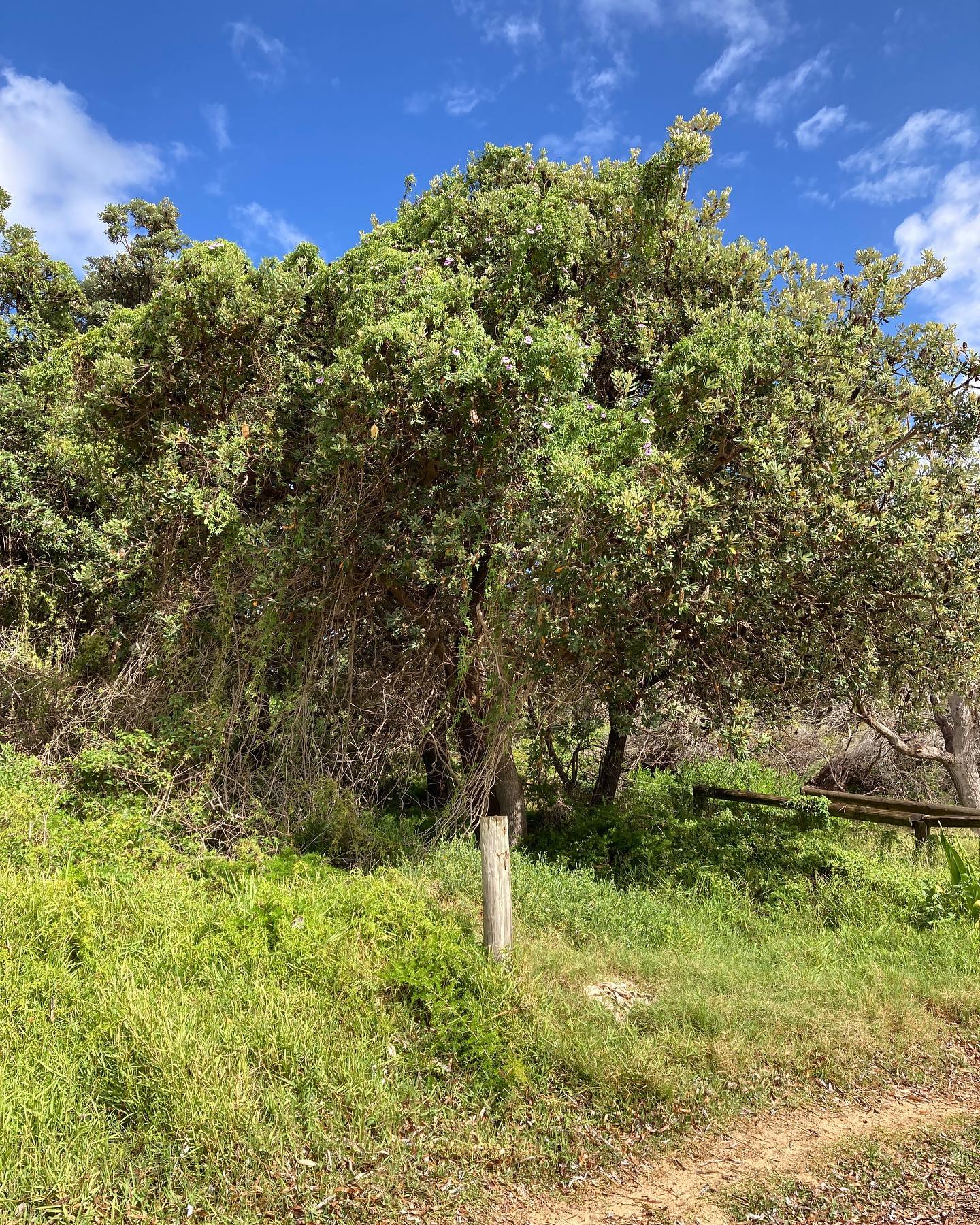
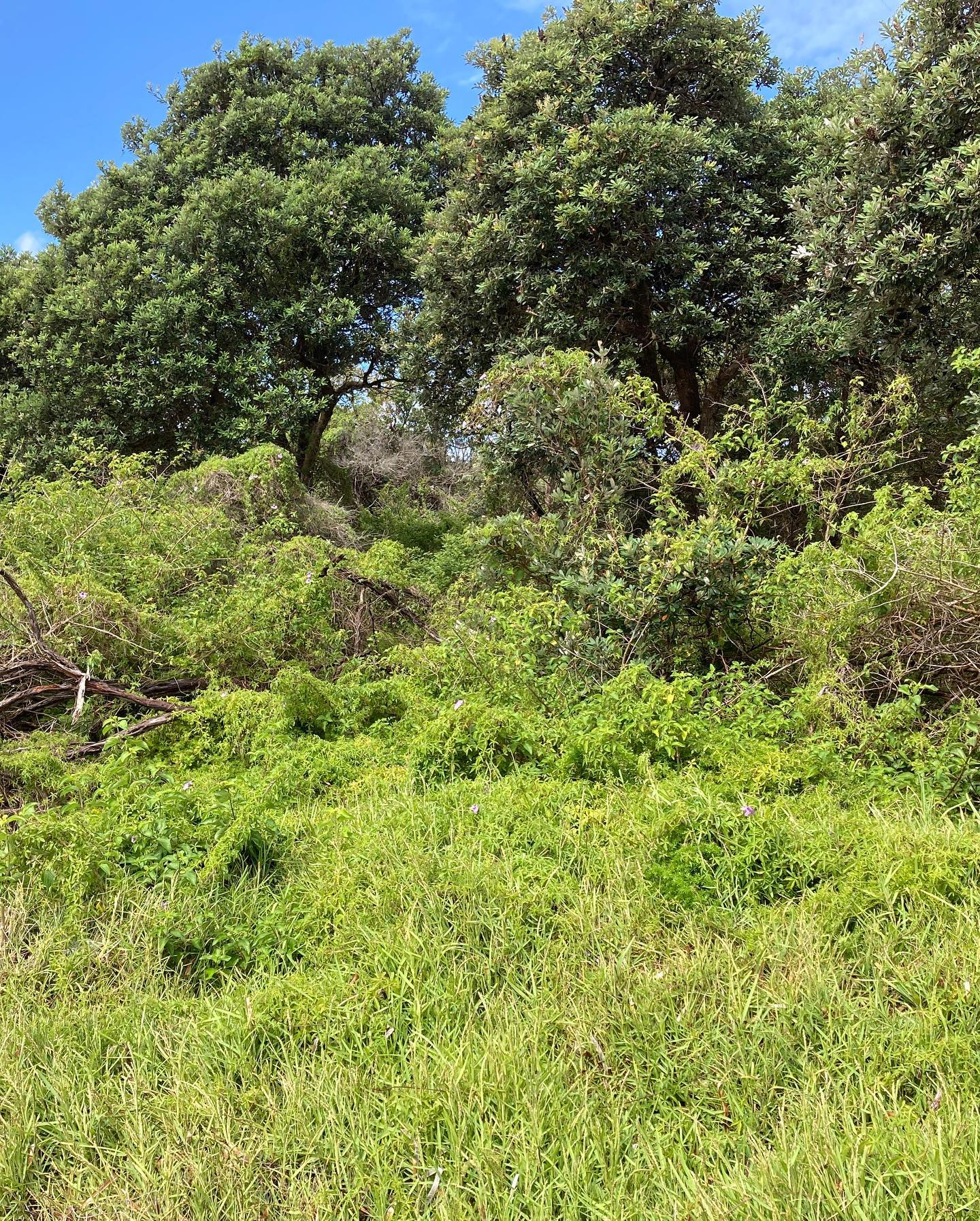
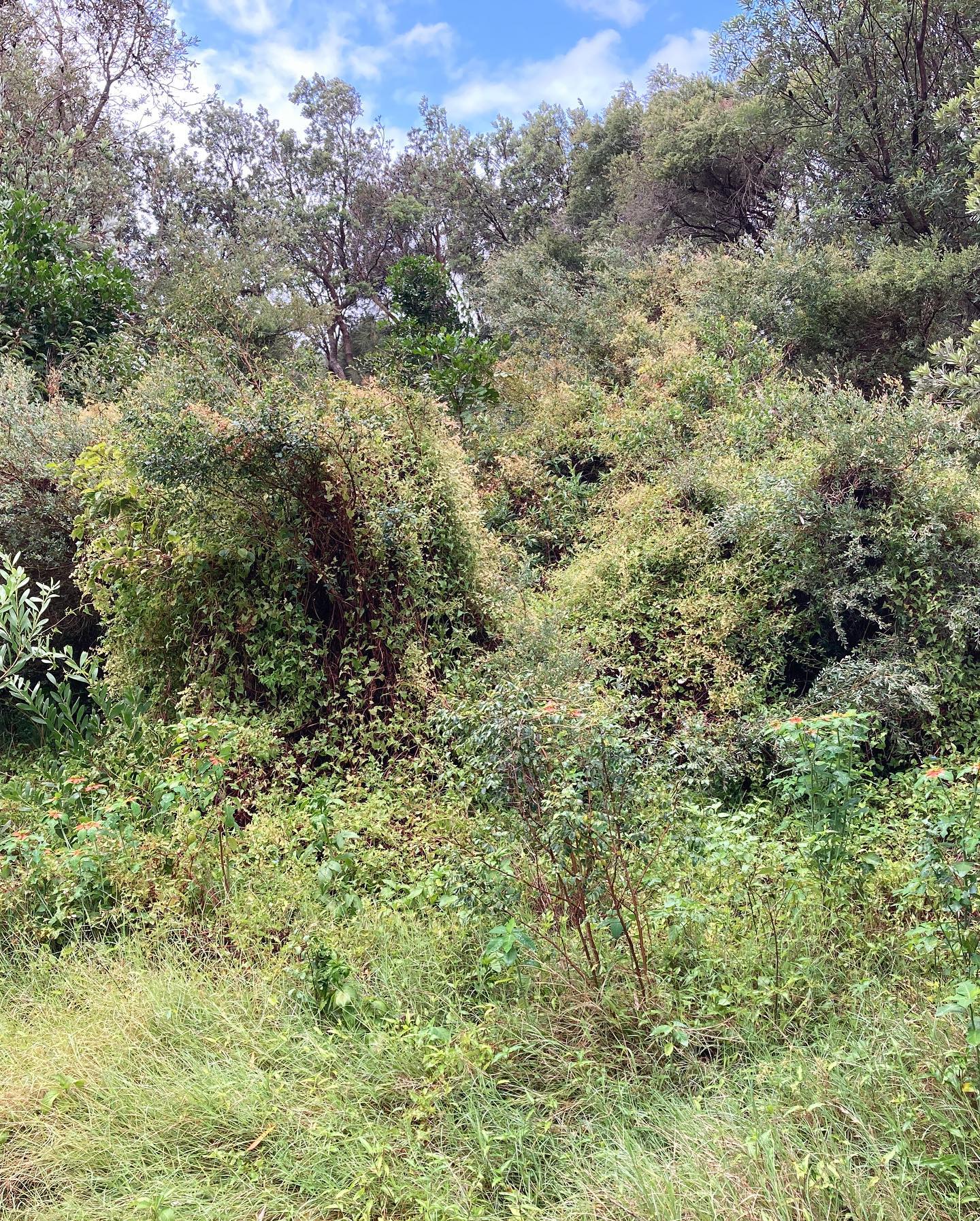
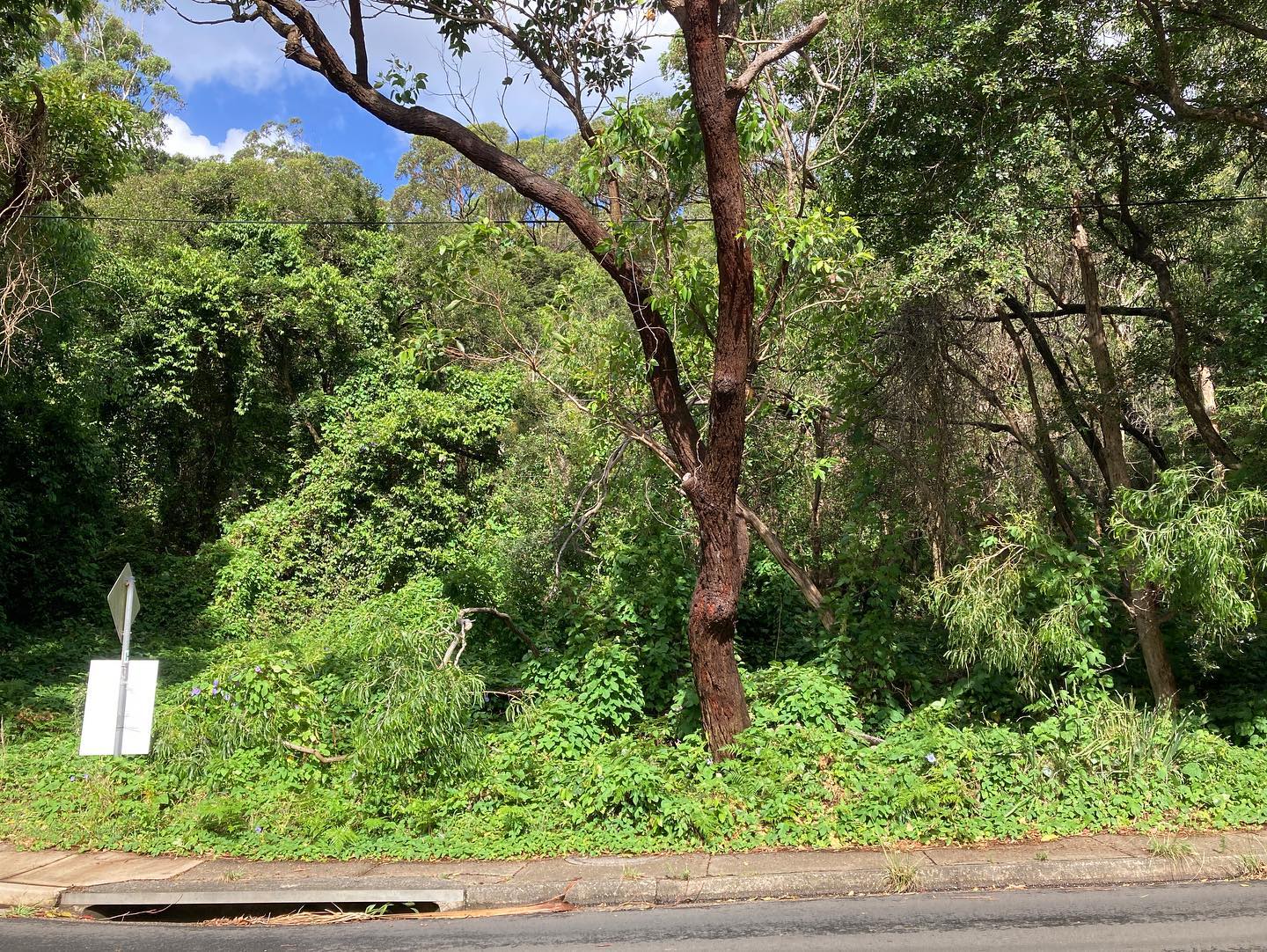
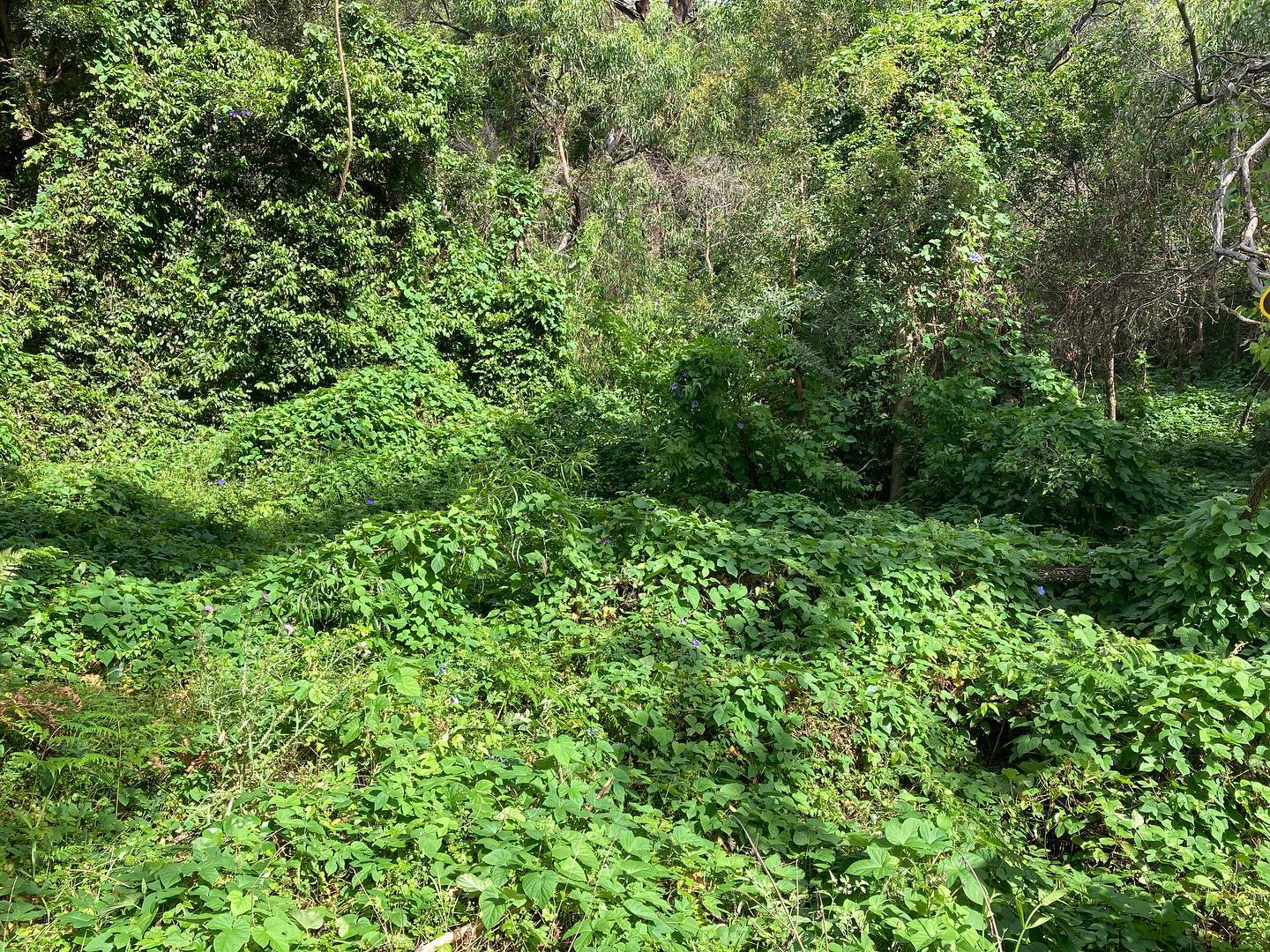
- the prevention, elimination, minimisation and management of the biosecurity risk posed or likely to be posed by weeds,
- to develop, implement, co-ordinate and review weed control programs
- to inspect land in connection with its weed control functions
- to keep records about the exercise of the local control authority’s functions under this Act
- to report to the Secretary about the exercise of the local control authority’s functions under this Act
Asparagus Fern Flowering Now: Dispose Of This Weed To Stop The Spread
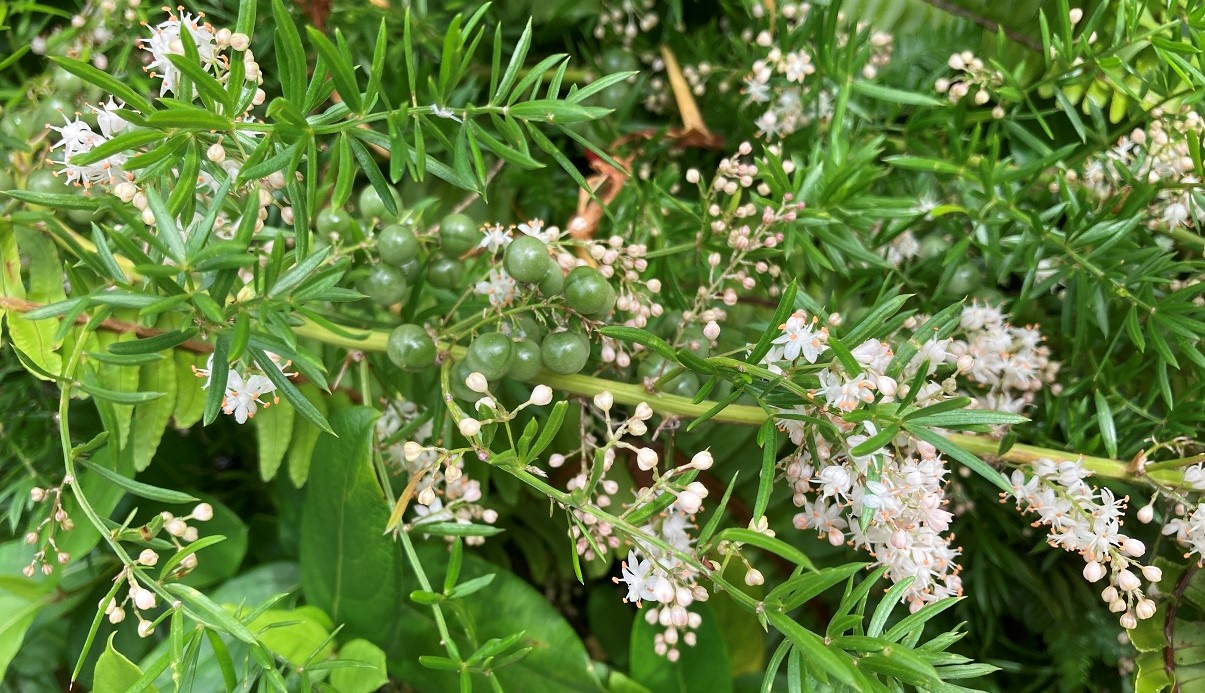
No Sediment Barriers At Collaroy-Narrabeen Sea Wall Site: Surfrider Foundation Northern Beaches February 4th Video Of Runoff + Extension North Proposal
(a) the integrity and resilience of the biophysical, hydrological (surface and groundwater) and ecological environment,(b) coastal environmental values and natural coastal processes,(c) the water quality of the marine estate (within the meaning of the Marine Estate Management Act 2014), in particular, the cumulative impacts of the proposed development on any of the sensitive coastal lakes identified in Schedule 1,(d) marine vegetation, native vegetation and fauna and their habitats, undeveloped headlands and rock platforms,(e) existing public open space and safe access to and along the foreshore, beach, headland or rock platform for members of the public, including persons with a disability,(f) Aboriginal cultural heritage, practices and places,(g) the use of the surf zone.
The Council has a further application currently on display for an extension of this wall towards North Narrabeen (DA2021/1612) between Clarke Street and Mactier, which its webpage states was 'advertised'. The cost of this section of works is listed as $ 2,047,433.00 of which 10% will be met by council and 10% by the state government - or 20% by taxpayers and ratepayers in real terms.
The proposed extension is described as;
'coastal protection works comprise a reinforced concrete wall supported on continuous flight auger (concrete) piles, either contiguous piles with plug piles or jet grout, or secant piles. Anchors attached to the wall (and permanently buried landward of it) have been designed to provide support for the wall and piling at times of beach erosion when sand levels lower on the seaward side of the wall'.
The piles extending below the surface have been designed as a complete and permanent barrier to soil migration through the wall.
This wall will be a 7.5 metre high design from its base as well, described as:
''A wave return (concrete face that slopes seaward and directs waves seaward) has been provided at the top of the concrete wall (which has a crest level of 7.0m AHD) to reduce wave overtopping of the wall. This wave return extends 0.5m seaward of the main face of the wall.''
The report on the Environmental Effects states that;
'It is recognised that long term recession due to projected sea level rise is expected to translate beach profiles upward and landward, thus reducing average beach widths over the long term where profiles are truncated at protection works (assuming that beach scraping and beach nourishment is not undertaken)'.
The council, in it's ‘Council Provides Facts On The Collaroy Residents’ Seawall’, has stated;
''Council will continue to manage the beach into the future - Council will continue to move sand from the entrance to Narrabeen Lagoon to Collaroy as required. We are also working with the NSW Government and Sydney Coastal Councils Group on proposals to bring additional sand onto our beaches in response to climate change from offshore marine sand deposits or from clean terrestrial sand. These types of programs are new and require the highest levels of environmental scrutiny before they could be progressed.''
These ongoing management costs will be met by residents - although the Narrabeen-Collaroy beachfront has been where sand has been dumped bi-annually from Narrabeen for decades, except now the costs will be met, since the amalgamation of the Manly, Warringah and Pittwater councils, by all in the new LGA.
In 2014 community consultation of Warringah Council residents was undertaken in regard to the Collaroy beachfront that resulted in the 2014 Coastal Zone Management Plan for Collaroy-Narrabeen Beach and Fishermans Beach.
In July 2016, weeks after the councils had been forcibly amalgamated and in response to the June 2016 storm, the NSW state government installed administrator Dick Persson outlined a Draft Coastal Erosion Policy for Collaroy that resulted in the December 2016 Coastal Zone Management Plan for Collaroy-Narrabeen Beach and Fishermans Beach being formalised under the same administration.
That Administrators Minute stated:
I am advised that the initial estimates for 1.1km of works from The Marquesas to 1096 Pittwater Road has been estimated at approximately $22 million. While Council will work with the State Government to meet the cost of directly protecting public assets in this area (approximately $5.5 million), I will also ask the State Government to join Council in providing up to 10% each towards the cost of private protection as a contribution subject to a positive cost benefit analysis for these public assets. Early estimates suggest this contribution could be approximately. This contribution has been estimated at approximately $3.3 million ($1.65 million from State and $1.65 million from Council) and is in recognition of the public asset protection that is provided by these private properties.....A recent report by the Sydney Coastal Council’s Group identified that to combat the impact of sea level rise in the Collaroy-Narrabeen embayment significant volumes of sand will be required as these impacts are felt. For example, it is predicted that some 1.3 million cubic metres of sand (approximately 4 times the amount removed during the June storms) will be required for the first 10 year nourishment effort, and around 420,000 cubic metres for each following 10 year campaign.In 2009 dollars this will cost around $30 million for the first 10 year nourishment, and around $12 million for each following 10 year campaign.These costs are based on the assumption that sand nourishment will be undertaken across large areas of the NSW coast and the costs shared accordingly.....Works on this scale are simply unaffordable for Northern Beaches Council on its own, and the responsibility for delivery of offshore sands must be shared with benefitting Councils and also with State and Federal Government. The State Government is obviously best placed to co-ordinate and manage such an undertaking, and I will write to the Premier to request that the State provides a long-term sand replenishment strategy for NSW that addresses the many issues I have raised, and amends the Offshore Minerals Act (1999) to enable effective medium and long term beach amenity to be preserved.
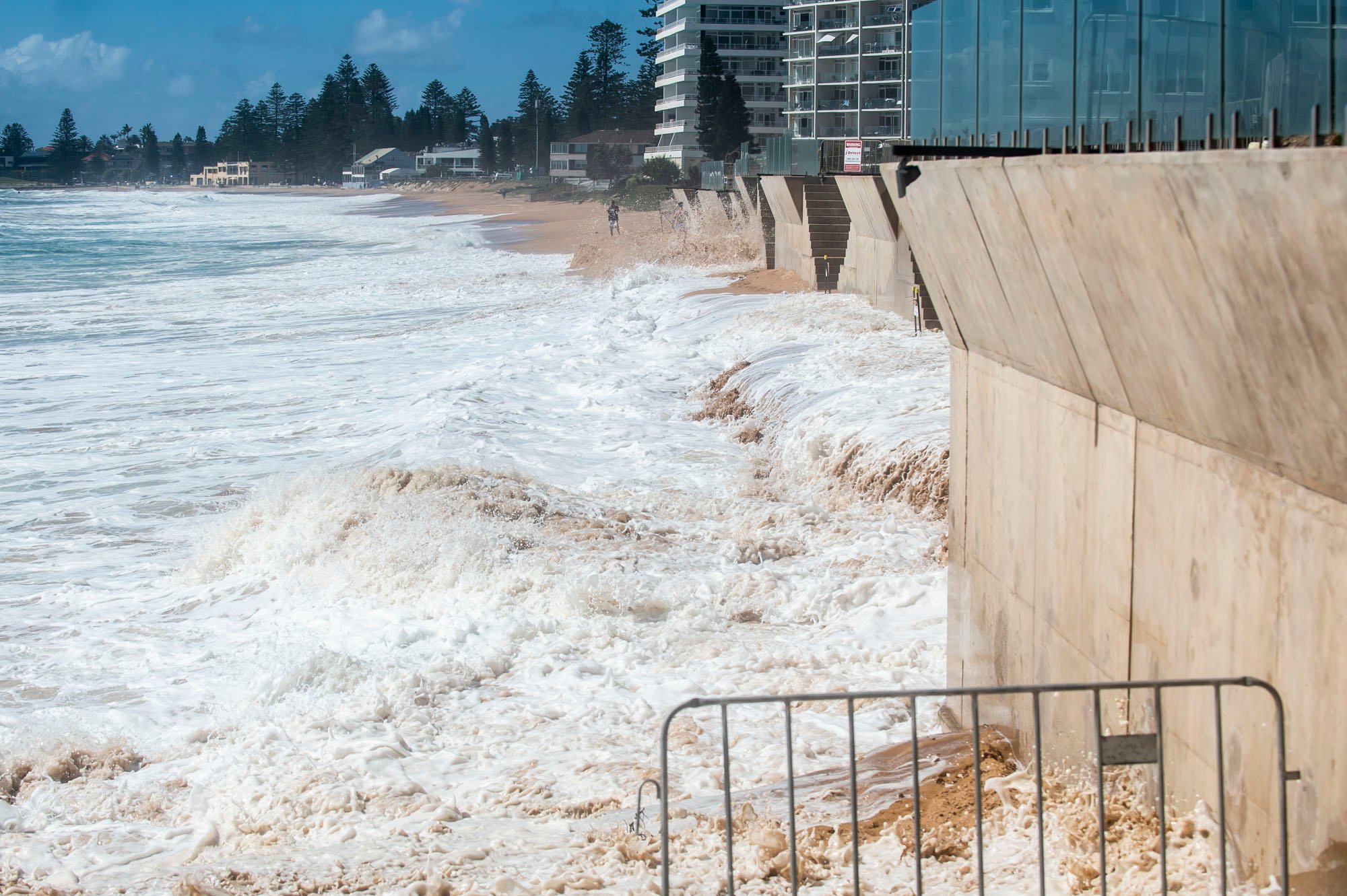
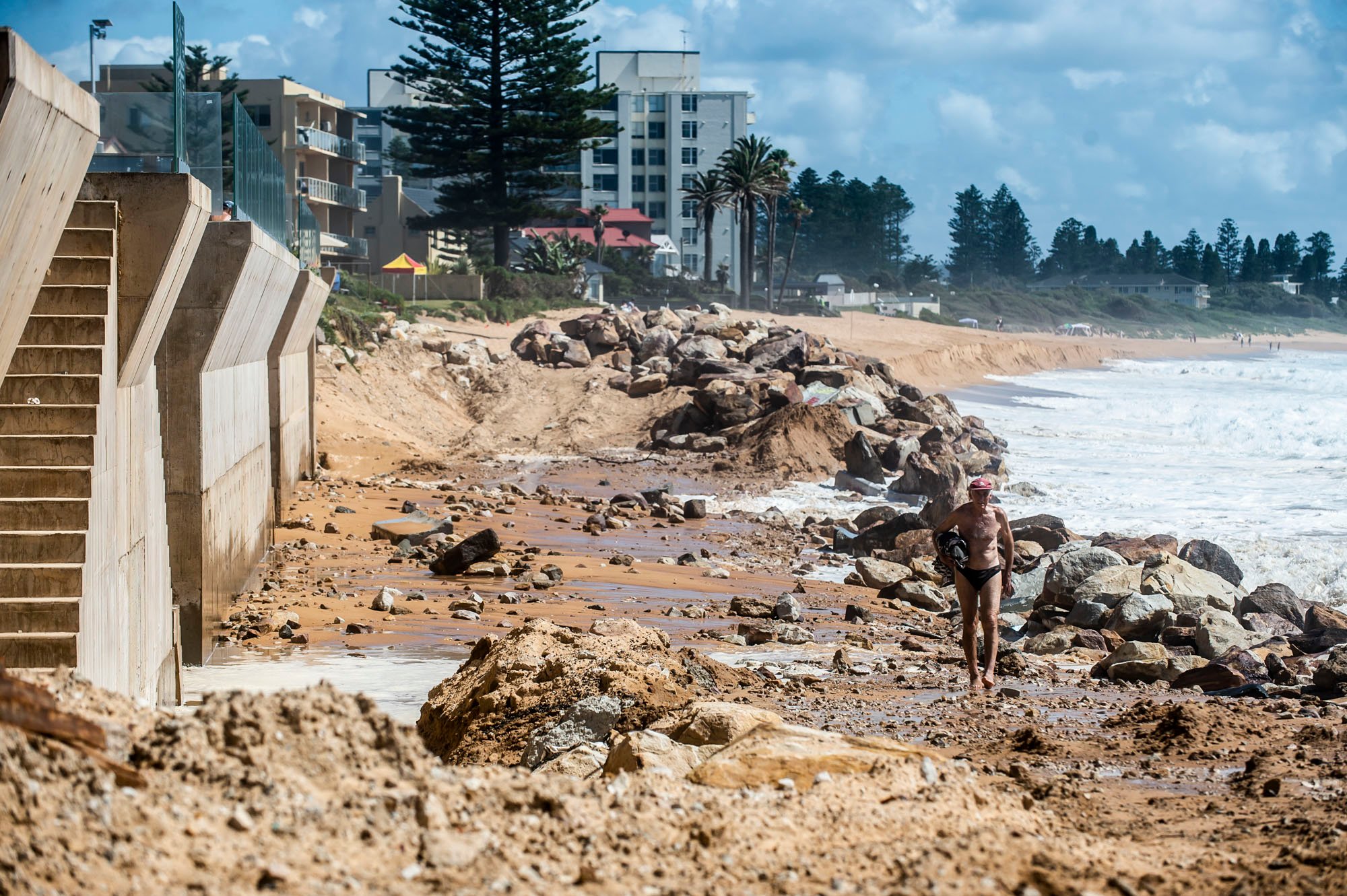
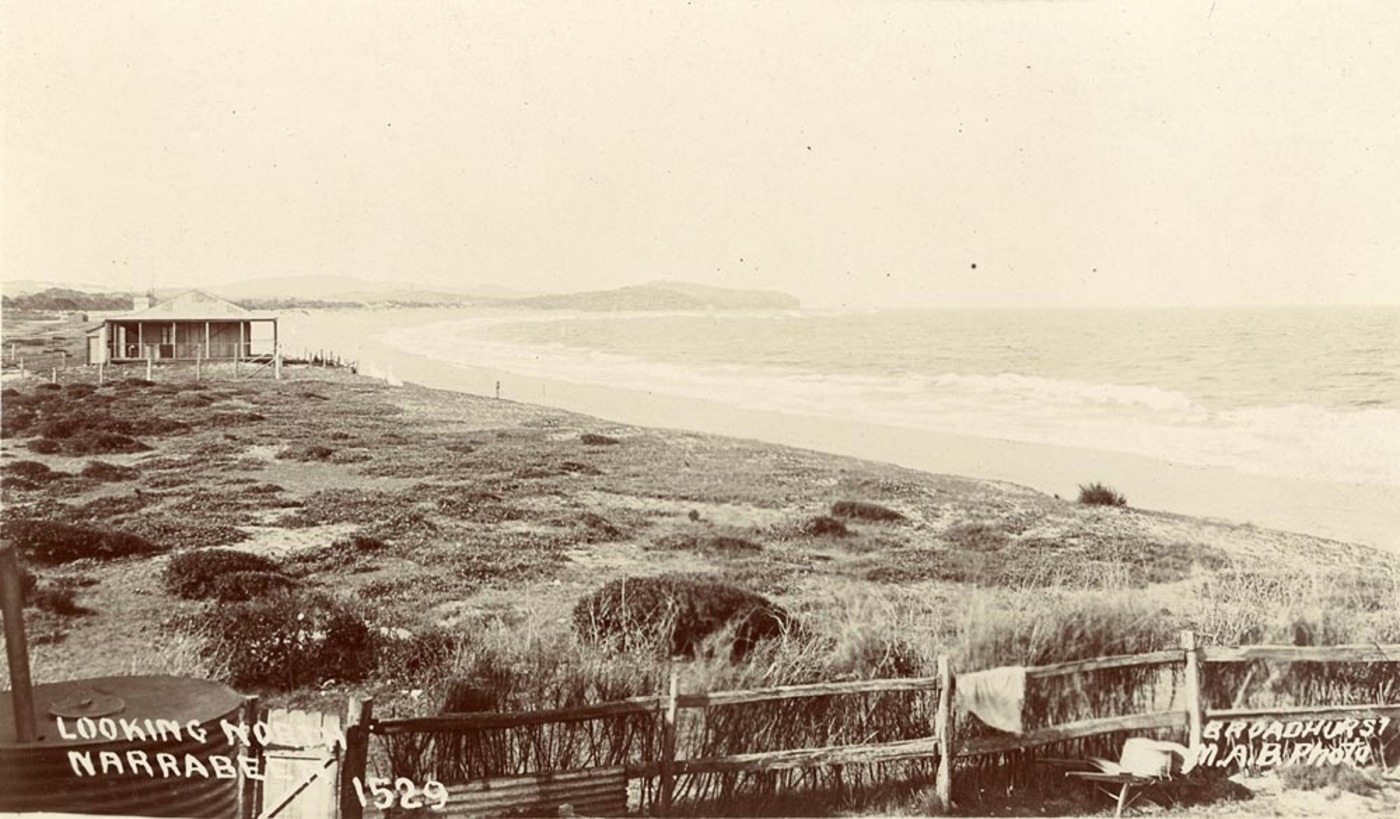
Looking north to Narrabeen, From Scenes of Narrabeen album, circa. 1900-1910 Sydney & Ashfield : Broadhurst Post Card, Images No.: a106058h and below; a105160h courtesy The Mitchell Library, State Library of NSW
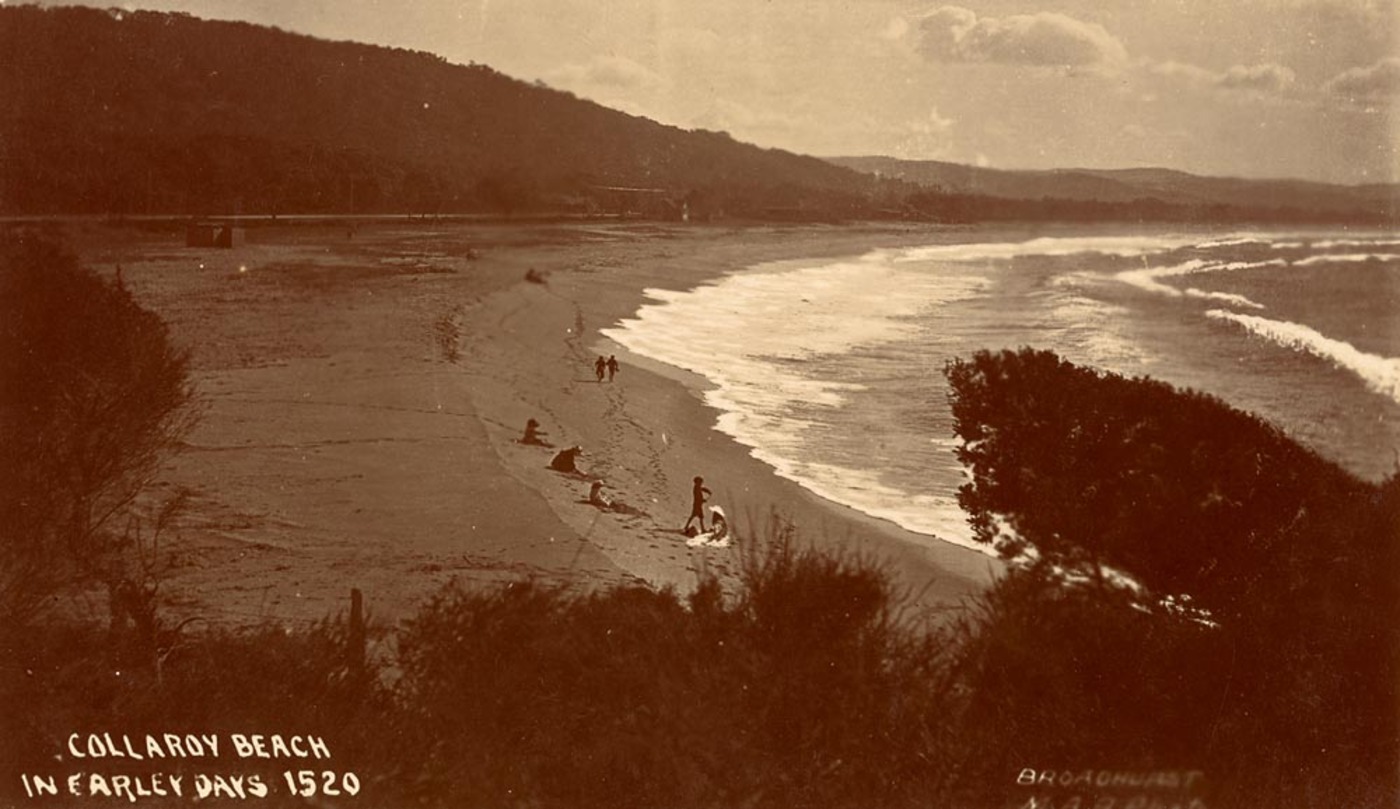
Collaroy Beach in earley [ie. early] days ca. 1900-1927; Sydney & Ashfield : Broadhurst Post Card Publishers, by William Henry Broadhurst, 1855-1927, courtesy State Library of NSW


Views north and south at North Narrabeen and Collaroy Beach Image Nos.: .a106051h a106052h, from Scenes of Narrabeen Album, Courtesy The Mitchell Library, State Library NSW.
On Friday, August 6th 2021 the council published ‘’Council Provides Facts On The Collaroy Residents’ Seawall’’ where Item 4 states; 'The current works are entirely on private land'
However, a February 20th, 2019 document by the NSW Department of Planning, Industry and Environment, ‘Notice of compulsory acquisition of land in the local government area of Narrabeen’ states;
‘The area of land 20m wide bound to the east by a line parallel to the eastern boundaries of Lots 6 to 8 Section 13 DP 111254, Lots 1 to 5 DP 10757, Lot 1 DP 121939, Lot A DP 167490 and Lot 1 DP 170202 and bound to the north by the prolongation of the northern boundary of Lot 8 Section 13 DP 111254 to the east and bound to the south by the prolongation of the southern boundary of Lot 1 DP 170202 to the east as indicated by hatching on the diagram below.’
The corresponding webpage states;
‘’ The DA is for a sloping rock revetment seawall, around 210 metres in length and 15 metres wide. The proposed structure, if approved, would encroach on Crown land by around 15 metres from property boundaries…’’
And;
‘’ The department has granted landowner’s consent for the DA to be assessed by Northern Beaches Council, which is required under Environmental Planning Assessment Regulations 2000. Landowner’s consent is not development approval. It is only the first step in the planning assessment. Should the DA be approved by Northern Beaches Council, the department will then begin negotiations on an appropriate tenure for the occupation of Crown land.’’
The compulsory acquisition of 20 metres of land was approved on February 20th, 2019. The approval included a diagram of the land compulsorily acquired:
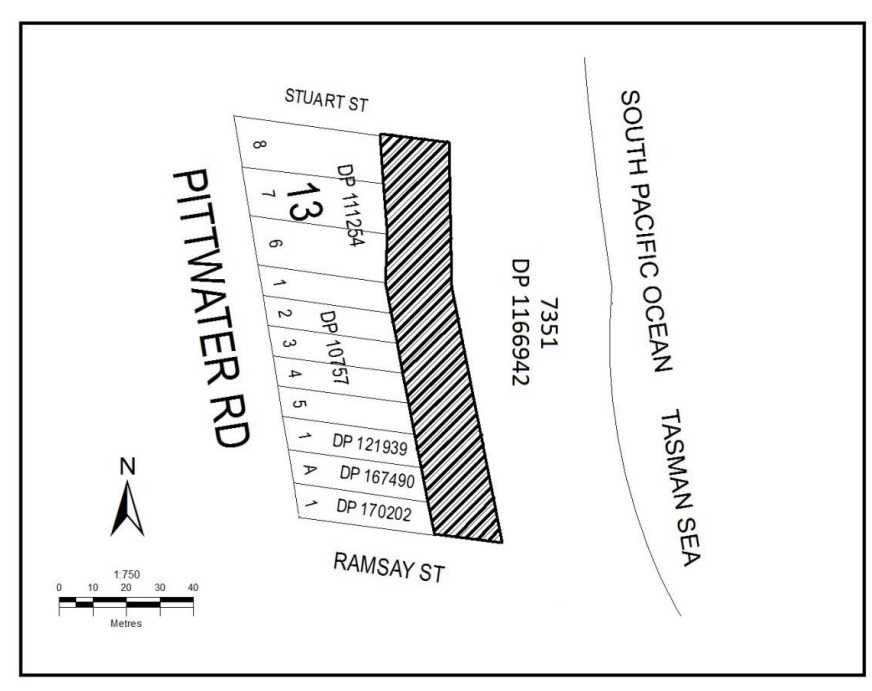
The Guardian Australia published a photo on October 24th, 2021 by Lewis Isaacs that shows how far east from the boundaries of the owners' private land this wall has been built.
That report is called 'A 7m wall has gone up on a Sydney beach: are we destroying public space to save private property?'
The south extension is causing anxiety for those who own these beachfront properties as well, with some submissions to the council DA2021/1612 webpage by those homeowners stating their mental health is being impacted, especially during storm events, and that 'the way forward isn't to punish the current residents of this strip of beach for the errors of the past.'
Other supporters state that without such walls the connection that is Pittwater road at Collaroy and Narrabeen will be cut off, as it has been in the past.
One Araucaria heterophylla, a Norfolk Island Pine, approx. 20m height at No.1204 Pittwater Road, is required to be removed as part of the extension north works.
Many studies have shown that with Climate Change storms are becoming more frequent and sea level rise will occur, prompting experts in the area of coastal engineering to state the council and the government need to acquire all these beachfront properties along this stretch of coast.
The council has already stated that to purchase all the beachfront property just at Collaroy would run to the many hundreds of millions of dollars and is outside the budget of a local council and that given the numbers of affected properties around the country, there are no state or federal government plans to use taxpayer dollars for a buy back scheme either.
The 377 beachfront lot addresses had a July 1, 2012 combined unimproved land value of $239 million, at an average of $635,000 per address. This average was skewed by the large number of units (which do not get individually valued), with the average unimproved land value per lot address (with 97 lot addresses) being $2.5 million. The largest unimproved lot land value was $12.5 million at “Marquesas” (11 Ocean Street Narrabeen) and the smallest was $1.2 million.
Ten years usually doubles the price of homes in this area, land value aside, although recently beachfront and waterfront properties at Palm Beach have been selling for in excess of $20 million each.
The extension north proposal is supported by the council's Building Assessment and Principal Planning officers.
However, the Coastal Act and the Coastal SEPP both state that “Development consent must not be granted……unless the consent authority is satisfied” and there are a list of matters the consent authority must be “satisfied” are met.
To be “satisfied” the consent authority has to have the qualifications and experience to be professionally satisfied. Reliance on external advice must be specific to the actual development location for the development type on the specific site and the specific location on that site.
The available information, other than information submitted by the applicant (which cannot be construed as independent advice) does not meet the necessary criteria and hence the consent authority has no basis on which to be satisfied.
The Local Planning Panel hearing for the DA '1 Clark Street Narrabeen' will be held on the 16th of March.
- Collaroy Seawall Prompts Calls For Residents To Join In Drawing A Line In The Sand
- Line In The Sand Demonstrators At Collaroy Sea Wall Call For A Better Solution Than Destroying This Public Beach
- Narrabeen Lagoon and Collaroy Beachfront: Storms and Flood Tides Of The Past
- The Narrabeen Lagoon - Collaroy Beachfront: Storms and Flood Tides Of The Past + Collaroy Beach Reserve Acquired By Warringah Shire Council
- June 2016 Storm Report with photos
- Pittwater Online News - Community News July 2016
- Pittwater Online News - Community News August 2021
- Unwelcome Sea Change: New Research Finds Coastal Flooding May Cost Up To 20% Of Global Economy By 2100
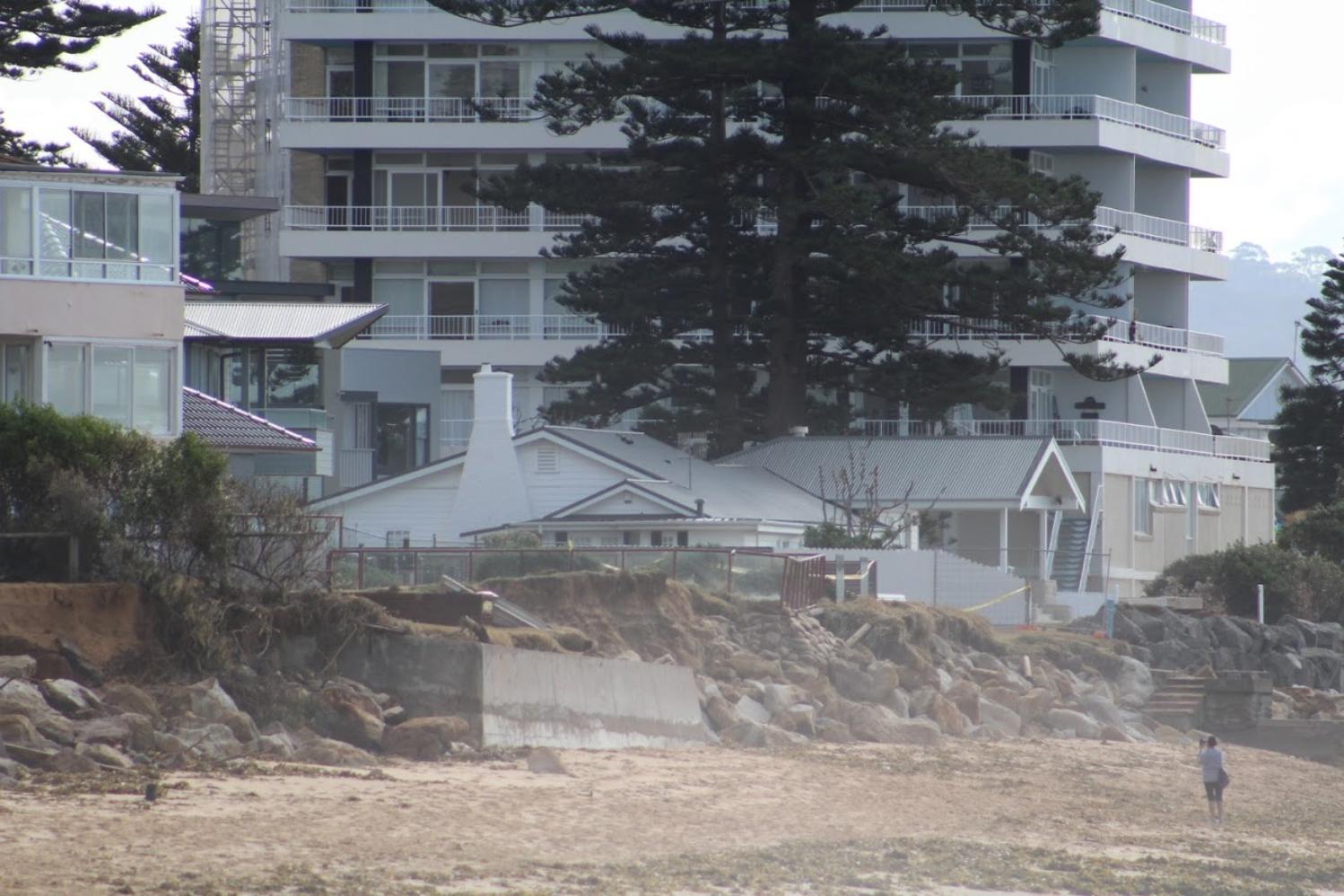
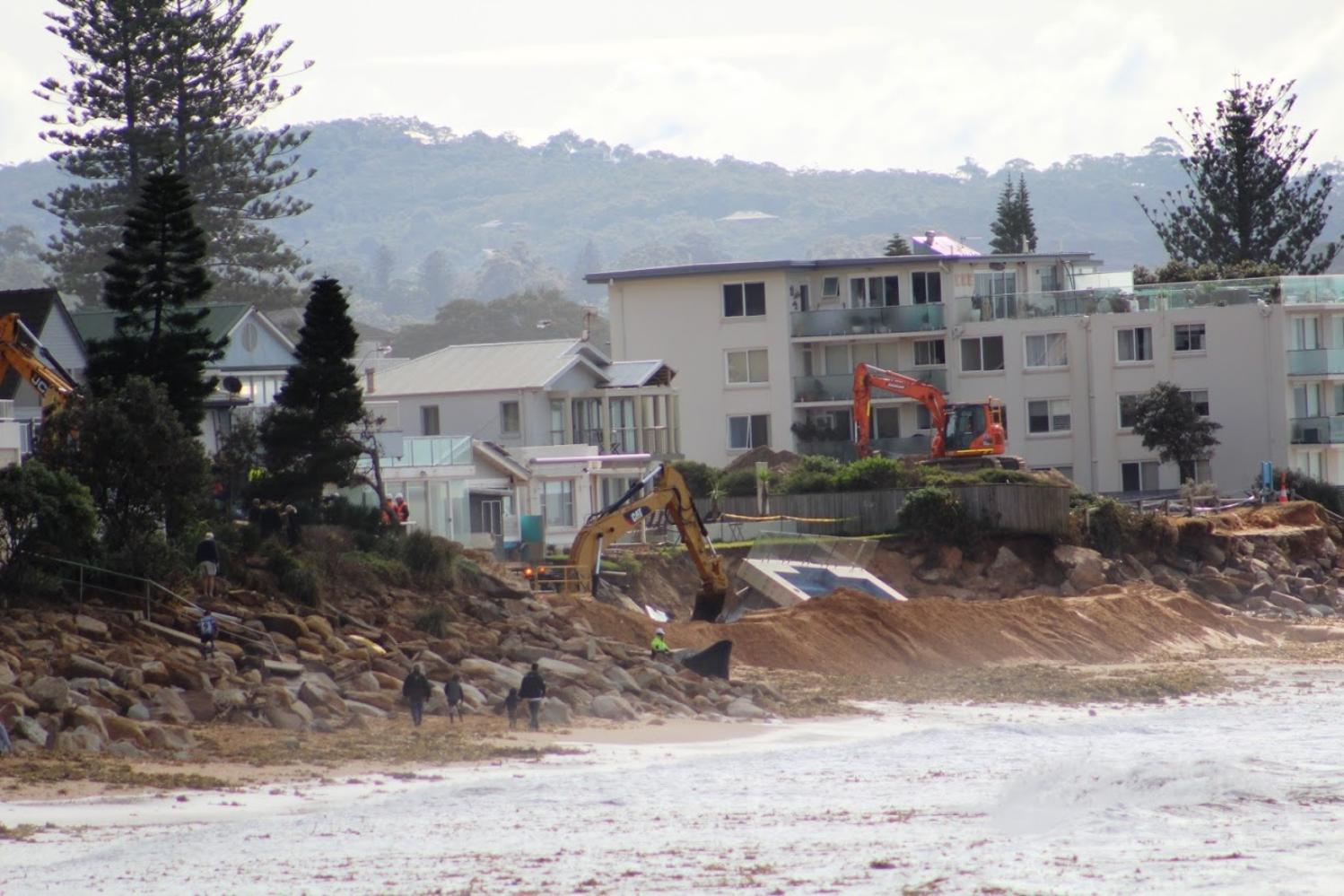
NARRABEEN/COLLAROY COASTAL EROSION 2016
Avalon Dunes Bushcare
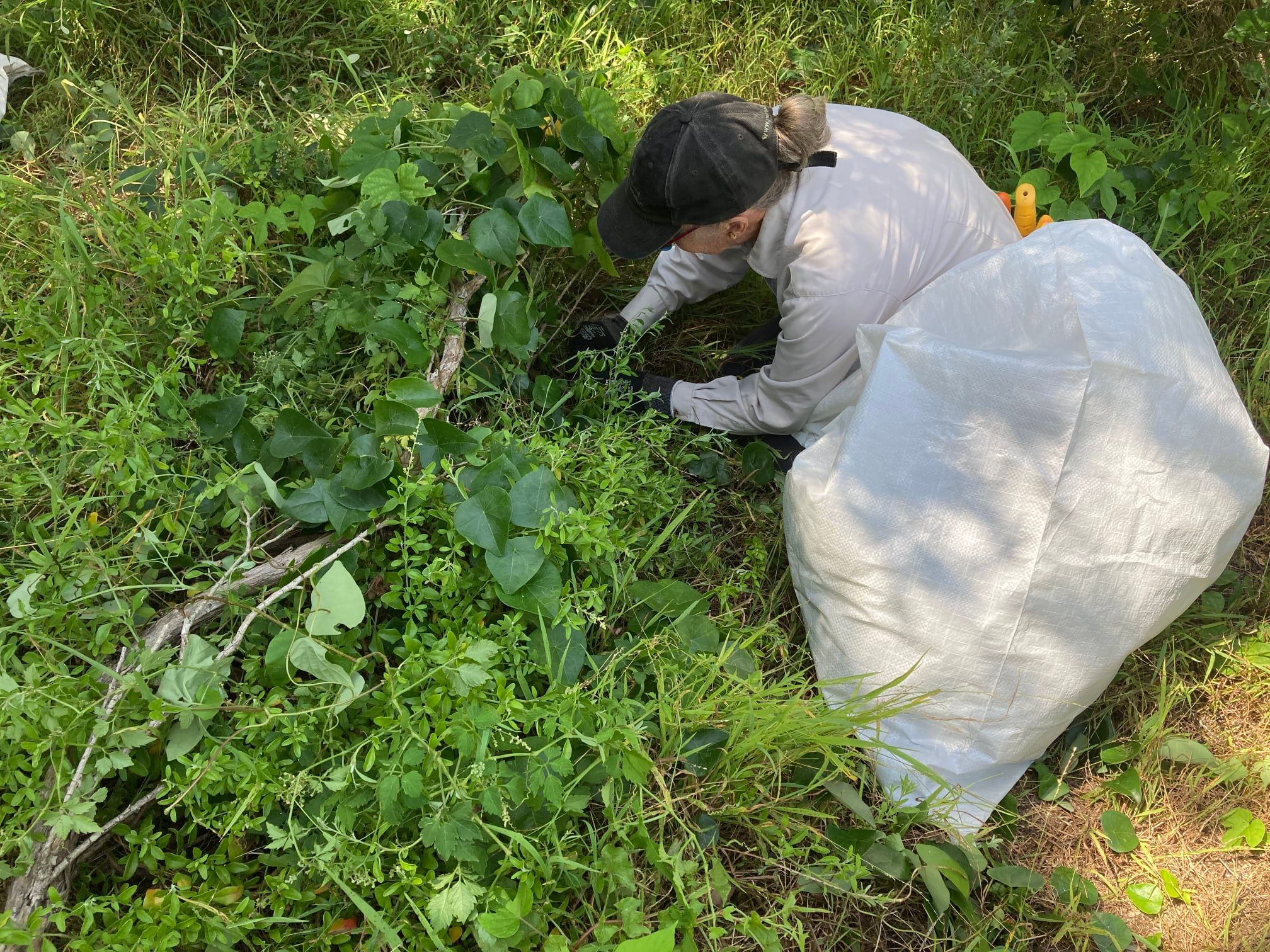
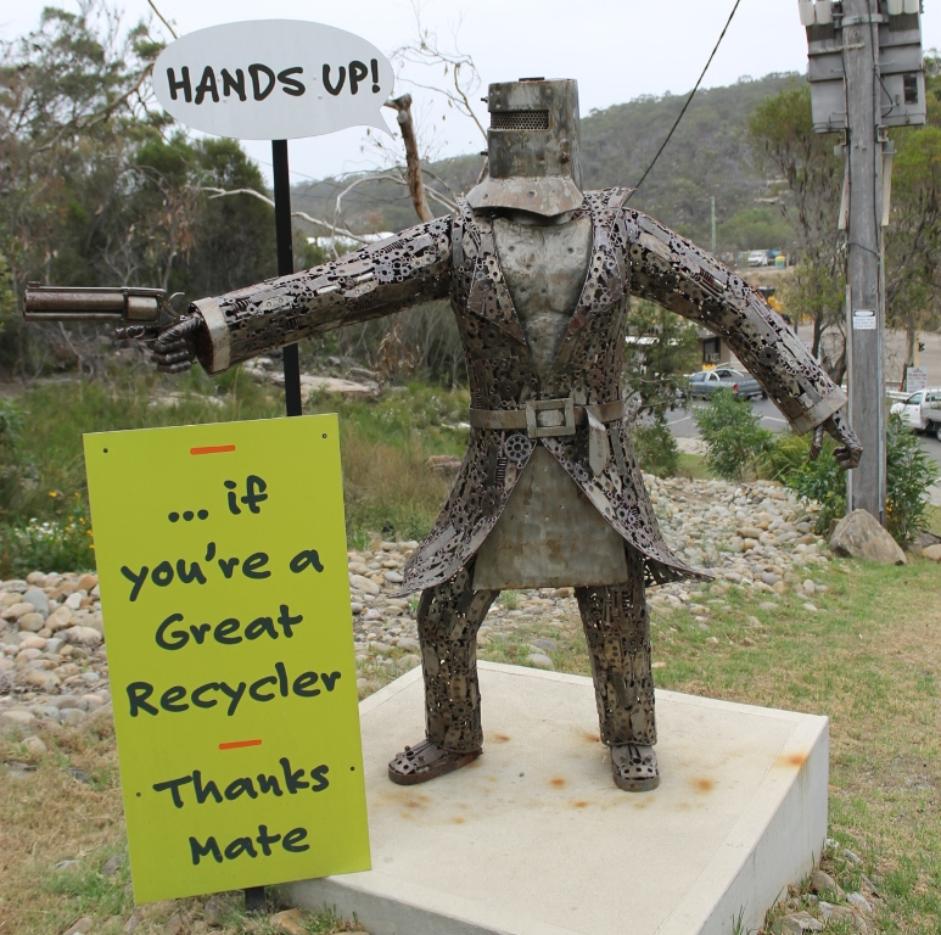
Ned Kelly sculpture at entrance to Kimbriki Resource Recovery Centre - made from discarded metals. Photo: A J Guesdon.
Friends Of Narrabeen Lagoon Catchment - Next Forum
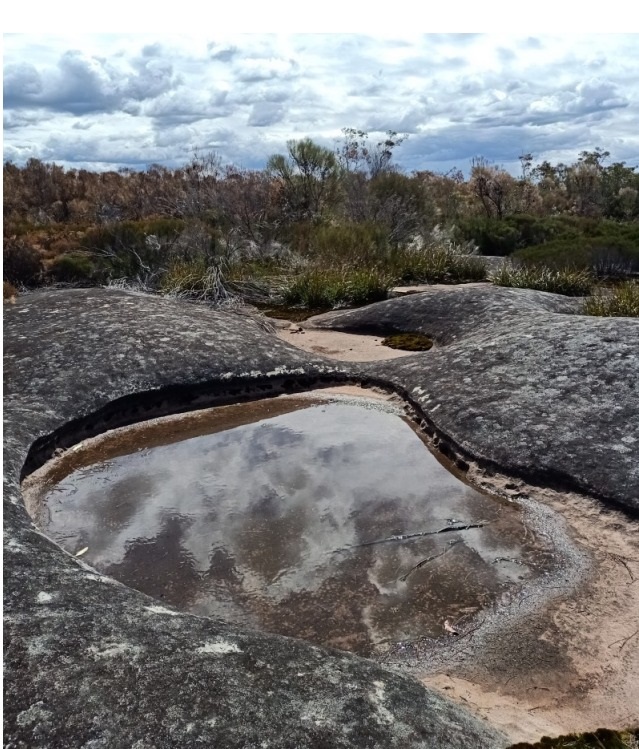
Northern Beaches Clean Up Crew Next Clean Is At: Queenscliff: Sunday 27th Of February

Bushwalkers Reminded To Be Prepared Before Heading Outdoors After Recent Rescues
- Take enough water, food and first aid supplies
- Register your trip on the National Parks and Wildlife Service website (trip intention form) at; https://www.nationalparks.nsw.gov.au/trip-intention-form
- Keep to a planned route
- Install the Emergency Plus application and take a Personal Locator Beacon (PLB), or satellite communication device, to use as a last resort
- Police received a notification from a GPS tracking device about two lost canyoners at Butterbox Point, Blue Mountains, about 6.10pm on Tuesday 11 January 2022. PolAir and Police Rescue conducted a search for the canyoners, locating the pair soon after. The men – aged 28 and 30 – were exhausted, and with night approaching the crew of PolAir winched them to safety. They were flown to a carpark at Mount Hay and assessed by paramedics, however they were uninjured.
- About 6pm on Thursday 17 February 2022, police received reports a 59-year-old woman had broken her leg while canyoning with three others at Butterbox Canyon. A NSW Ambulance helicopter winched the woman to safety, and she was flown to hospital in a stable condition. Police Rescue and NSW Ambulance paramedics hiked into the area and located the remaining three people, a woman and man aged in their 50s and a 15-year-old girl. They were uninjured. The rescue party stayed with the group overnight, before everyone was flown out the following day.
- About 9pm on Monday 3 January 2022, emergency services were called after two women – aged 27 and 24 – and two teenage girls – both aged 16 – became lost while bushwalking at Clover Hill Trail, Macquarie Pass, with only a small amount of food and water in their possession. Police asked the younger woman to install the Emergency Plus application on her phone to provide coordinates for their location. Police Rescue, with assistance from Lake Illawarra Police District, and NSW State Emergency Service (SES), conducted a search for the group, locating them just before 11pm between Clover Falls and Mulagong Falls. They were assessed by NSW Ambulance paramedics but were uninjured.
- Two bushwalkers contacted police after becoming lost and running out of water near the Wollangambe River at Mount Wilson about 7pm on Friday 31 December 2021. The pair – a 28-year-old woman and a 30-year-old man – provided their coordinates and PolAir 4 was able to locate them atop a ridge. PolAir landed nearby and the pair were brought onboard the aircraft before being flown to a landing site near Mount Wilson Rural Fire Service. They were uninjured.
- About 3pm on Saturday 1 January 2022, a 52-year-old man was walking along a coastal track in the Royal National Park when he fainted and twisted his ankle at Burning Palms Beach. Lifeguards responded and contacted emergency services. The man was assessed by NSW Ambulance paramedics before being transported by PolAir to the Burning Palms carpark. He was further assessed by paramedics for minor injuries.
Bushcare In Pittwater
Where we work Which day What time
Avalon
Angophora Reserve 3rd Sunday 8:30 - 11:30am
Avalon Dunes 1st Sunday 8:30 - 11:30am
Avalon Golf Course 2nd Wednesday 3 - 5:30pm
Careel Creek 4th Saturday 8:30 - 11:30am
Toongari Reserve 3rd Saturday 9 - 12noon (8 - 11am in summer)
Bangalley Headland 2nd Sunday 9 to 12noon
Bayview
Winnererremy Bay 4th Sunday 9 to 12noon
Bilgola
North Bilgola Beach 3rd Monday 9 - 12noon
Algona Reserve 1st Saturday 9 - 12noon
Plateau Park 1st Friday 8:30 - 11:30am
Church Point
Browns Bay Reserve 1st Tuesday 9 - 12noon
McCarrs Creek Reserve Contact Bushcare Officer To be confirmed
Clareville
Old Wharf Reserve 3rd Saturday 8 - 11am
Elanora
Kundibah Reserve 4th Sunday 8:30 - 11:30am
 Mona Vale
Mona Vale Mona Vale Beach Basin 1st Saturday 8 - 11am
Mona Vale Dunes 2nd Saturday +3rd Thursday 8:30 - 11:30am
Newport
Bungan Beach 4th Sunday 9 - 12noon
Crescent Reserve 3rd Sunday 9 - 12noon
North Newport Beach 4th Saturday 8:30 - 11:30am
Porter Reserve 2nd Saturday 8 - 11am
North Narrabeen
Irrawong Reserve 2nd Saturday 2 - 5pm
Palm Beach
North Palm Beach Dunes 3rd Saturday 9 - 12noon
Scotland Island
Catherine Park 2nd Sunday 10 - 12:30pm
Elizabeth Park 1st Saturday 9 - 12noon
Pathilda Reserve 3rd Saturday 9 - 12noon
Warriewood
Warriewood Wetlands 1st Sunday 8:30 - 11:30am
Whale Beach
Norma Park 1st Friday 9 - 12noon
Western Foreshores
Coopers Point, Elvina Bay 2nd Sunday 10 - 1pm
Rocky Point, Elvina Bay 1st Monday 9 - 12noon
Gardens And Environment Groups And Organisations In Pittwater
Sydney Wildlife Rescue: Helpers Needed

First Records Of Killer Whales Hunting Blue Whales: Western Australia
The Path To Renewable Fuel Just Became Easier

Number Of Earth's Tree Species Estimated To Be 14% Higher Than Currently Known With Some 9,200 Species Yet To Be Discovered
The ancient, intimate relationship between trees and fungi, from fairy toadstools to technicolour mushrooms

Environmental scientists see flora, fauna and phenomena the rest of us rarely do. In this series, we’ve invited them to share their unique photos from the field.
You may be familiar with the red toadstool with white spots, which are often the homes of fairies in children’s stories. These toadstools are also a small part of grander magical story: they are striking examples of mycorrhizas.
Mycorrhizas (pronounced my-cor-rye-zas) is the name for fungi associated with the root systems of many plants including trees, shrubs, groundcovers and grasses. These relationships are mutually symbiotic, which means both members benefit.
Fungi have a deeply ancient evolutionary origin, and colonised land with the first plants around 500 million years ago to form these partnerships. We humans often underestimate their importance to the ecosystems that have shaped life on earth.
So let’s take a closer look at how this relationship works and why it’s so important for Australian ecosystems.
An Intimate Relationship
Fungi come in a beautiful diversity of shapes, sizes and colours. The following photos by my co-author Mark Brundrett are just a few examples of those growing in southwest Australia.
Mycorrhizas are not to be confused with fungi that decompose dead plant matter (saprophytes) or those that cause disease (pathogens).
Saprophytes are fungi that recycle nutrients, and these can also be large and impressive. They can create tree hollows, which provide shelter for nesting birds and other animals such as possums.
The ethereal ghost fungus, for example, is a saprophyte. It famously glows green in the dark, and recycles nutrients in ecosystems by breaking down dead wood.

The primary role of mycorrhizas, on the other hand, is to provide resources such as phosphorus and nitrogen to flowering plants. They also effectively increase the absorptive surface area of the plant’s root system, allowing plants to take up much-needed water and nutrients so they grow better and more quickly.
In return, the plants provide carbohydrates, a product of photosynthesis, which mycorrhizas require to grow.
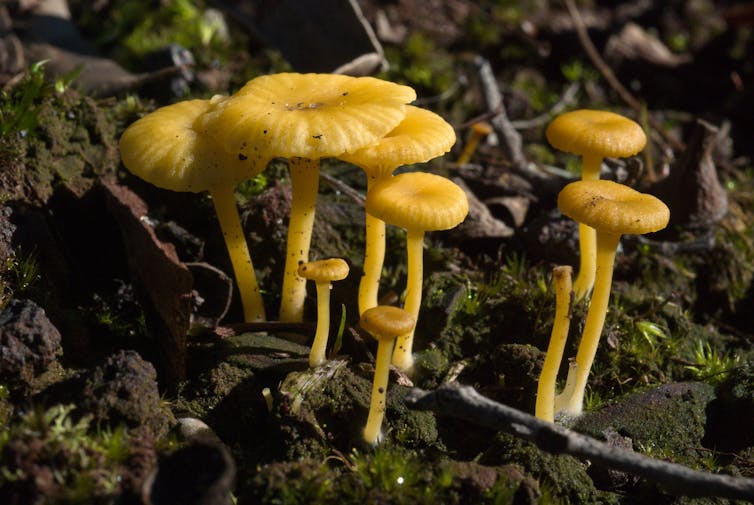
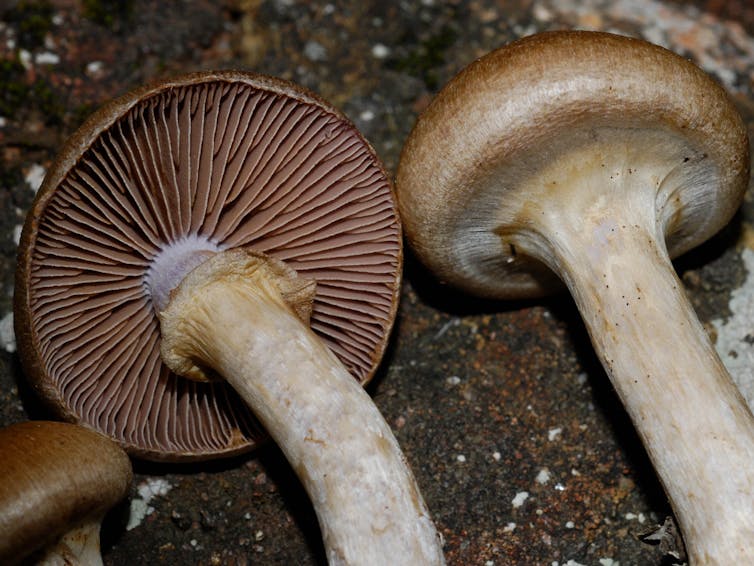
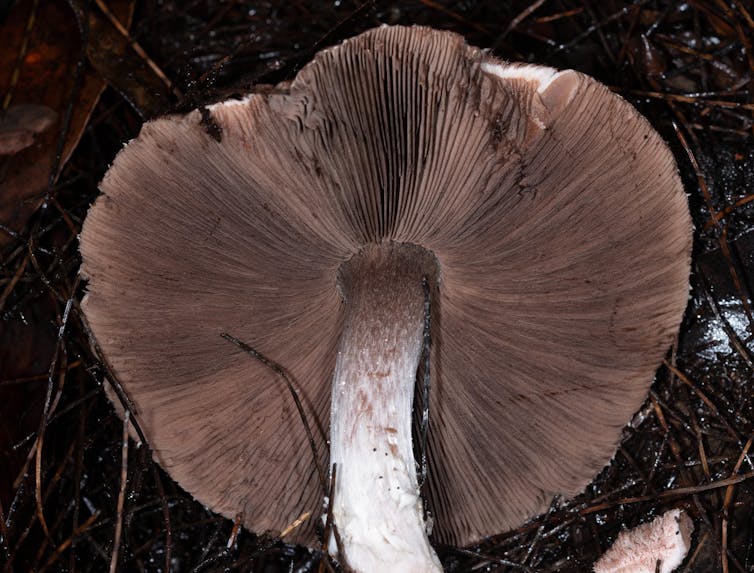
There are five different types of mycorrhizas, and two of these are particularly important in Australian ecosystems. One type is called “ectomycorrhiza”, where fungi wrap their hyphae (long, very fine hair-like structures that contact the soil) around the plant roots underground but don’t penetrate the root cells.
The other, called “endomycorrhiza”, is where fungi grow into the plant root, penetrating and branching within the root cells to form what look like little, microscopic trees. This is about as intimate a relationship between different types of organisms as you can get!


Mushrooms As Big As Dinner Plates
We often become aware of the presence of mycorrhizas only when conditions for reproduction are right, and a mushroom or toadstool emerges from the ground. Such conditions may only occur every five to ten years. For some species, there may be centuries between reproductive events.
For many of us, our experience with mycorrhizal fungi begins in very early childhood when we first catch sight of those spotty red and white toadstools, called the fly agaric or Amanita muscaria.
These fungi are often depicted in children’s book illustrations, such as Little Red Riding Hood, Jack and the Beanstalk, and a number of Enid Blyton’s tales. I recall conifers, such as pine trees, often growing nearby in the background of these pictures. This was no coincidence, Amanita muscaria forms mycorrhizal associations with many conifers, as well as oaks.


The mycorrhizal fungi associated with eucalypts can be less showy, with many being 75-100 millimetres across and a creamy, light tan in colour. They quite often pop up in home gardens, frequently in lawns, where they’re very obvious and usually within 4 to 5 metres of a tree trunk.
Others are spectacular, including the bright purple, orange or green Cortinarius species shown in the photos below. In fact, the beauty and diversity of our fungi now supports a new ecotourism industry in Australia, particularly in Tasmania.

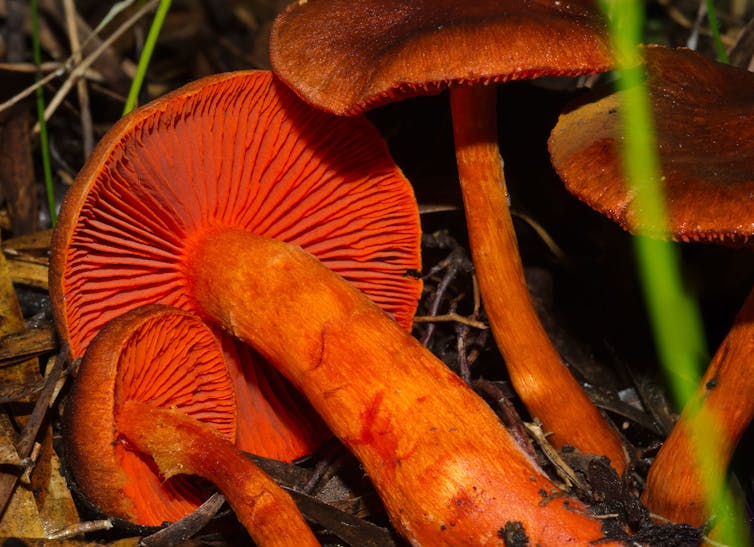
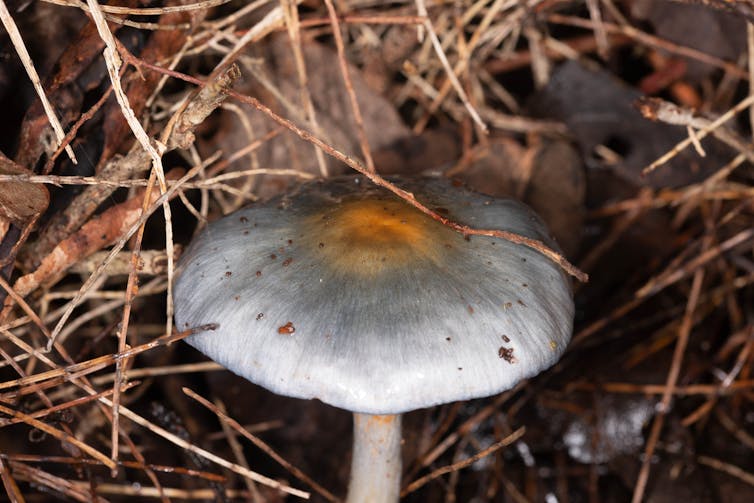
Some fungi are most impressive in the spring following bushfires, such as the abundant orange cup fungus shown below that stabilises ash beds.
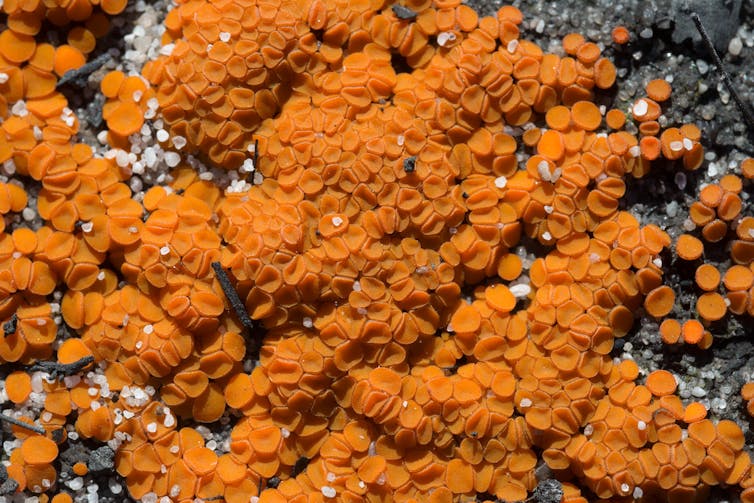
Indeed, most plants form mycorrhizal associations. Those that don’t include plants from the common vegetable families brassicaceae (think broccoli, cauliflower, kale) and chenopodiaceae (spinach, beetroot, and quinoa). Neither do members of the proteaceae family, such as native banksias and grevilleas. These plants invest in very complex roots rather than fungal associations.
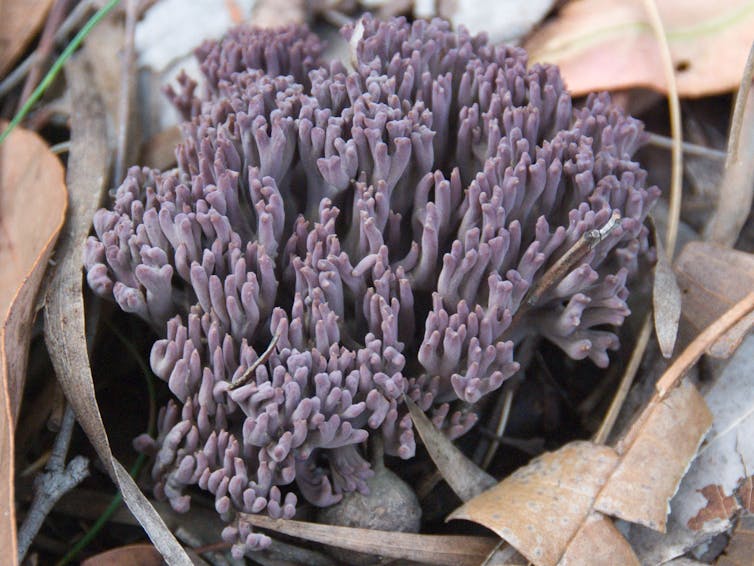
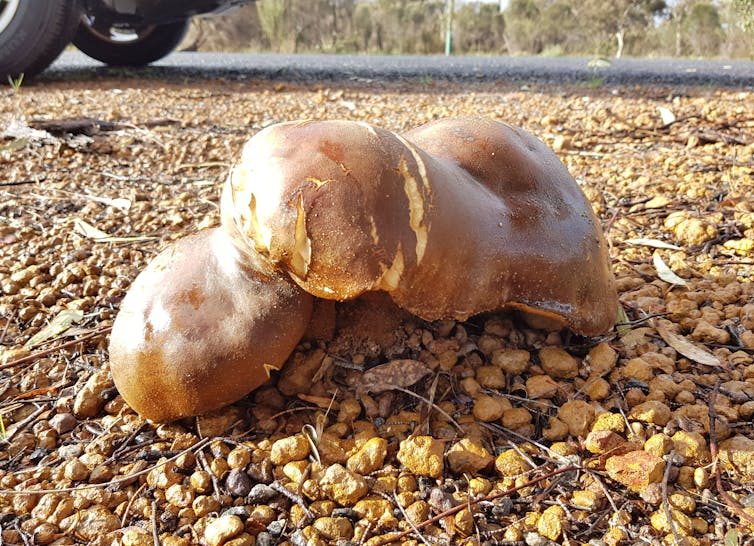
Who’s Really In Control?
Because we are so familiar with many of the plants in our environment, we are inclined to think it’s them that control their relationship with mycorrhizal fungi.
But it is possible mycorrhizal fungi exercise much more control. Or perhaps, the relationship is a perfect mutualistic symbiosis where partners share everything, including control, equally. We just don’t know yet.
Members of the fungus kingdom work in synchrony with the plant kingdom to support all terrestrial life, including animals such as ourselves. We may not think about fungi very often, but we cannot survive without them.
One of the surprise elements of Douglas Adam’s Hitchhiker’s Guide to the Galaxy, was that the Earth and its inhabitants existed as part of an experiment designed and controlled by white laboratory mice.
I sometimes wonder if the fate of the Earth’s terrestrial ecosystems rests on mycorrhizal fungi. If so, perhaps we need to show them greater respect.![]()
Gregory Moore, Doctor of Botany, The University of Melbourne and Mark Brundrett, Adjunct Associate Professor, School of Biological Sciences, The University of Western Australia
This article is republished from The Conversation under a Creative Commons license. Read the original article.
Queensland has an important network of private conservation areas, but they’re dangerously exposed to mining
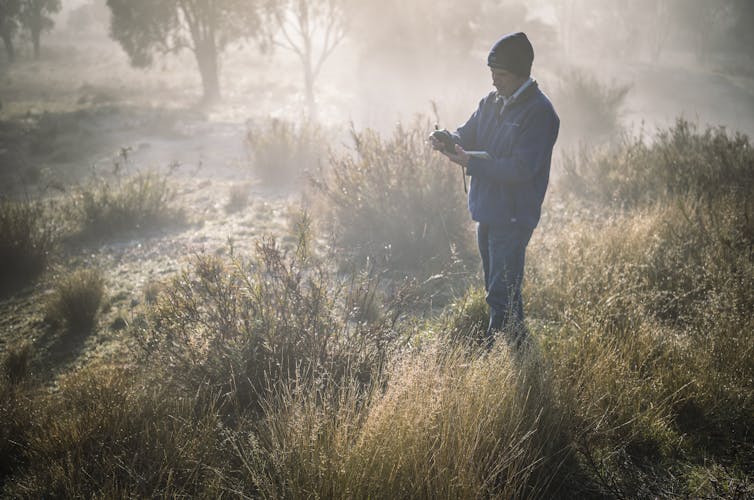
Australia has the world’s largest network of privately owned conservation areas that protect a range of rare wildlife, from bilbies to endangered fish.
There are some 6,000 non-government conservation areas across the continent, which are owned by Aboriginal and Torres Strait Islander groups, individuals and NGOs. They build a more comprehensive protected area network than public protected areas can achieve alone, ensuring more species have a fighting chance against the changing climate.
These lands cover more area in Queensland than any other state. But our new research finds Queensland’s laws fail to protect them from the hidden impacts of mining on the groundwater sustaining them.
This is because private investments in conservation land aren’t legally protected in the same way as commercial assets or capital, nor like national parks. To safeguard these crucial habitats and ecosystems against the threats of mining, we need legal reform in Queensland and an urgent exploration of these vulnerabilities across Australia.
Beyond National Parks
Governments rightly encourage growth in Australia’s privately protected areas. Conservation landholders invest in restoring degraded land, re-introduce ecologically and culturally important species, and carefully design innovative habitat protection measures.
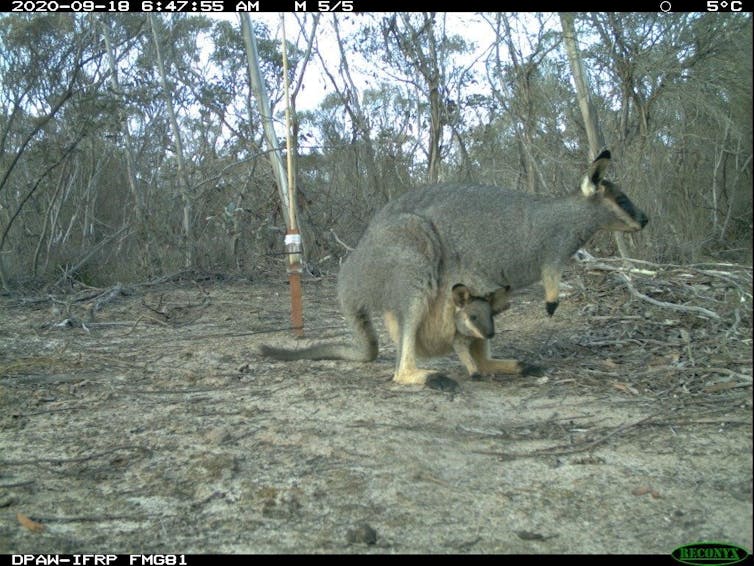
For example, the Olkola Aboriginal Corporation of Cape York has developed a successful carbon abatement project and a long-term plan to save the totemic endangered Alwal (golden-shouldered parrot), and defend it from mining.
Likewise, a non-profit organisation owns the Mount Rothwell reserve. After successfully reintroducing the mainland eastern barred bandicoot in 2004, the reserve now protects over 80% of the species’ population in the largest feral predator-free ecosystem in Victoria.
Privately protected areas also safeguard some of Australia’s most threatened and under-protected habitat types. This includes critically endangered grassy box woodlands in New South Wales, and the Fitz Stirling biodiversity hotspot in Western Australia.
Investing in privately protected areas also makes economic sense. A 2020 Ernst & Young report shows investing in privately protected areas can provide significant stimulus to support Australia’s recovery from COVID.
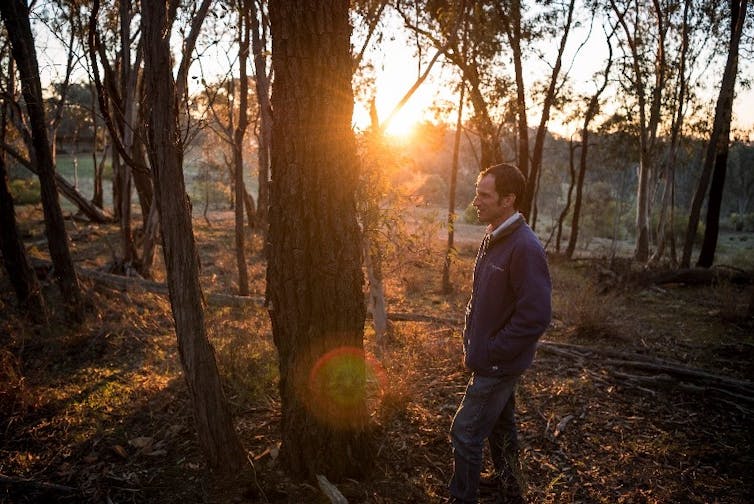
Why Private Conservation Land Is Vulnerable
But Australia’s environment laws leave privately protected areas exposed to resource development projects, both within and outside the boundaries of the land.
Unlike national parks, mining projects are allowed to be developed within privately owned nature refuges against the land owner’s wishes. This has been a longstanding concern of conservationists worldwide.
Only very small areas of environmentally valuable private land in Queensland are protected from mining under legal arrangements that are very rarely applied. This includes a single declared Special Wildlife Reserve (a recent legal upgrade from nature refuge arrangements), and parts of Queensland’s strategic environmental areas.
Both privately protected land and national parks are also at risk from development projects operating outside their boundaries. One of the biggest threats is the impact of mining on groundwater, the focus of our research.
Groundwater is natural life support for arid Australia, with ecosystems and landscapes – such as desert springs, wetlands, rivers and forests – dependent on it. Alongside the potential for water contamination, a major threat mining and gas developments pose on groundwater is over-extraction.
Mines and gas developments can require billions of litres of fresh water each year to operate, competing with water that ecosystems need to survive. These impacts can last for hundreds or even thousands of years, though the details aren’t always fully disclosed.
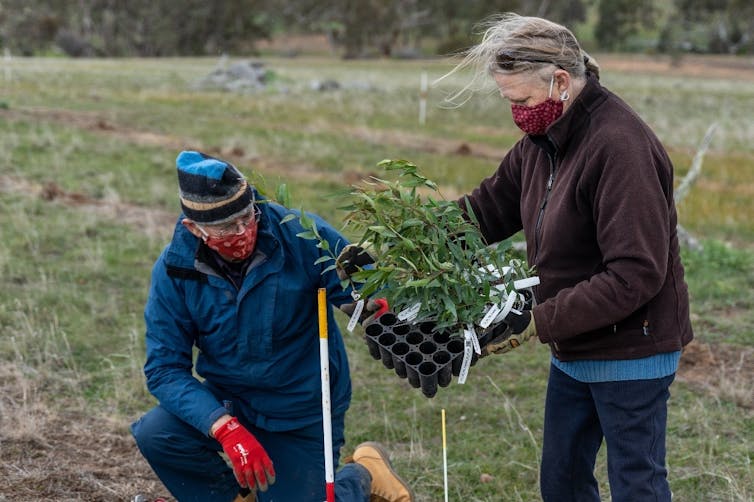
We untangled the complex web of environmental, mining and water laws regulating mining and gas developments in Queensland, and found three key biases that leave nature refuges vulnerable.
1. Land title boundaries can act like legal blinkers on risk
Even if there are scientific studies predicting long-range impacts, there are no requirements for miners or governments to tell conservation landholders that a mine will likely affect them, unless their land is next door.
If a conservation landholder isn’t aware of an impact to their land, then they can’t object to a project or appeal a decision to approve it, and might make futile ecological investments. They also can’t protect infrastructure like bores, which miners’ assessment processes have overlooked in the past.
2. Policies focus on damage to built and commercial infrastructure
This includes damaged roads and fences, or dead livestock. Laws and policies don’t consider or require compensation for damage to ecological investments in conservation areas. This is despite governments claiming progress in private conservation land towards international conservation targets.
3. Cumulative impacts can be ignored
Queensland’s environmental laws don’t require a government decision-maker deciding on whether to approve a mining project to consider cumulative effects. The damage from one project might seem tolerable on its own, but not when it’s considered alongside others in the region. Some policies briefly mention this, but they aren’t detailed or legally binding.
Queensland’s water laws are better, but still only require companies and governments to predict impacts to springs, and suggest strategies to respond. This means preventing and mitigating impacts – such as shrinking or drying spring-fed wetlands – is legally optional and they can ignore other groundwater-dependent ecosystems and climate change.

What Needs To Change?
Removing these legal blinkers requires law reform:
all landholdings scientifically predicted to experience changes due to a mine should be notified
any protection, mitigation and compensation provisions should recognise investments in conserving and restoring native species and ecosystems, not just houses, fences and livestock
risks to nature refuges must be understood as cumulative to avoid a death by a thousand cuts.
In the meantime, conservation landholders can take steps to protect themselves. For example, sector leaders could aggregate public information about resource development applications and alert conservation landholders who might miss them.
Landholders should document how they rely on bores and how they invest in conserving and restoring ecological assets. They could apply for licences to use groundwater for ecological or wildlife purposes to better defend their water resources.
Our complex laws haven’t kept up with Australia’s increasing reliance on private investment in wildlife conservation. Securing permanent environmental benefits from private land means protecting it from the compounding, long-term effects of extractive industries.![]()
Rebecca Louise Nelson, Associate Professor in Law, The University of Melbourne and Rebecca Spindler, Adjunct associate professor, UNSW
This article is republished from The Conversation under a Creative Commons license. Read the original article.
Labor’s plan to green the Kurri Kurri gas power plant makes no sense

Is it possible to have your cake and eat it too? Federal Labor is certainly giving it a go by supporting government plans for a fossil gas/diesel peaking plant in the Hunter Valley currently under construction – as long as the plant switches to green hydrogen by 2030.
This is disappointing for three reasons.
One, we don’t actually need the Kurri Kurri power station. It will be a government-built white elephant.
Two, retrofitting it to burn hydrogen would be so expensive as to be unrealistic.
And three, burning hydrogen for power is about the least useful thing you can do with it.
The gas/diesel plant under construction and Labor’s hydrogen proposal came from the realm of politics. It should have stayed there.
Why Did Labor Switch Its Position?
Labor has long been split on the Kurri Kurri power station, which has been touted as a way to augment dispatchable generation. At first, Labor denounced the Morrison government’s plans, with climate change spokesman Chris Bowen describing it as a “cynical attempt to pick a fight on gas and continue the climate wars, or to reward the major Liberal donor who owns the Kurri Kurri site”.
Now they say it will create jobs and help provide reliable and affordable electricity.
As a nod to climate change action, Labor leader Anthony Albanese and climate spokesman Chris Bowen announced the switch with the caveat that Kurri Kurri will use green hydrogen to power 30% of its production when the plant enters service in 2023 and 100% by 2030. Labor says it is prepared to spend up to another $700 million on the plant.
It has been widely suggested the proposed plant is the government’s way to take advantage of Labor’s internal divide.
When the plant was first proposed for the small town 35 km inland from Newcastle, Energy Security Board chair Kerry Schott questioned its viability. “Nobody is going to build it from the private sector because it doesn’t stack up,” she said.
She’s right. It didn’t stack up then and doesn’t stack up now, regardless of how it’s powered.

The Power Plant No One Needs
When my colleagues and I took a deep dive into this proposed power station, we found there was no need for it until at least 2030. That’s the best case. But as time goes by it is increasingly unlikely it will ever be needed as much cheaper and more efficient alternatives including batteries come to meet the increasing demand for stored energy.
That’s to say nothing of the fact the initial proposal would only have had enough gas stored to run for six hours and then take a day to recharge. Snowy Hydro has since upped these plans to 10 hours of storage.
And Snowy Hydro’s price tag of $600 million? Fiddlesticks. It will cost vastly more. We estimate well over $1bn when costs of the pipelines, storage and other infrastructure are included, even without hydrogen. As a result, there is no way Kurri Kurri would attract enough income to recover its costs. It’s hardly surprising private investors are steering clear. Why bankroll a dud?
But Isn’t It Good To Make Gas Plants Greener?
You can add up to 10% of hydrogen to conventional gas fired turbines without trouble. And you can use hydrogen as the primary fuel in turbine-based power plants, as South Korea has done using hydrogen produced as a by-product in the process of refining oil.
The problem is the two Kurri Kurri turbines ordered by the government can run on a maximum of 15% hydrogen. Snowy Hydro suggests the turbines could be extended to a maximum 30% hydrogen mix, with changes to the internal equipment and piping. But the gas lateral pipeline/storage system is only being constructed to accommodate a 10% mix, and would need to be completely rebuilt to transmit a higher blend.
In short, converting Kurri Kurri to hydrogen means completely rebuilding the plant and its pipeline and storage infrastructure. These are not minor changes.

Let’s imagine Labor is elected and proves determined to press ahead with these plans. Where, exactly, will they get the green hydrogen from and how will it be stored to run the plant? At present, the world has no large scale source of climate-safe hydrogen produced from water. While there is a great deal of interest in large scale electrolysis – the process where we split water to get hydrogen and oxygen – there is a long road ahead.
Let’s Not Waste Time On Distractions
Is that the end of the issues plaguing this plant? Nope. Even if we get to the point where green hydrogen is plentiful, burning it in a combustion turbine is one of the most wasteful ways to use it.
That’s because combustion turbines are very inefficient ways to produce electricity. They waste half the energy they consume in the form of heat vented to the atmosphere. That alone makes the use of hydrogen in turbines uneconomic. In fact, we doubt hydrogen will ever be used in combustion turbines to produce electricity. There is absolutely no need to bother doing so, given much better alternatives already exist. Batteries already dominate the market for new storage in Australia and elsewhere and this will surely continue.
We’d be much better off using green hydrogen to decarbonise more difficult industries, such as the production of fertiliser, in industrial processes and chemical manufacturing, and for long-distance land or sea heavy freight where hydrogen still has a weight advantage over batteries.
There are enormous challenges to be met in the transition towards renewable energy and away from fossil fuels. These kinds of obviously economically and technically infeasible proposals serve only to set us back. We should give these plans short shrift.
Independent engineer Ted Woodley contributed to this article.![]()
Bruce Mountain, Director, Victoria Energy Policy Centre, Victoria University
This article is republished from The Conversation under a Creative Commons license. Read the original article.
UK Plants Flowering A Month Earlier Due To Climate Change
 Using a citizen science database with records going back to the mid-18th century, a research team led by the University of Cambridge has found that the effects of climate change are causing plants in the UK to flower one month earlier under recent global warming.
Using a citizen science database with records going back to the mid-18th century, a research team led by the University of Cambridge has found that the effects of climate change are causing plants in the UK to flower one month earlier under recent global warming.Satellites And Light Reflections Help RMIT Researchers Spot Coastal Plastic Waste
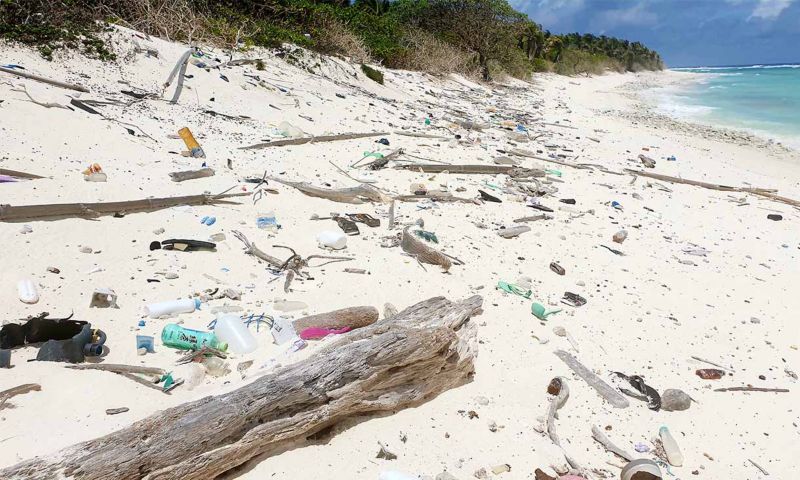
Scientists Uncover 'Missing' Plastics Deep In The Ocean: 51 Trillion Microplastics In World's Oceans
Ocean Eddies Could Explain Antarctic Sea-Ice Paradox
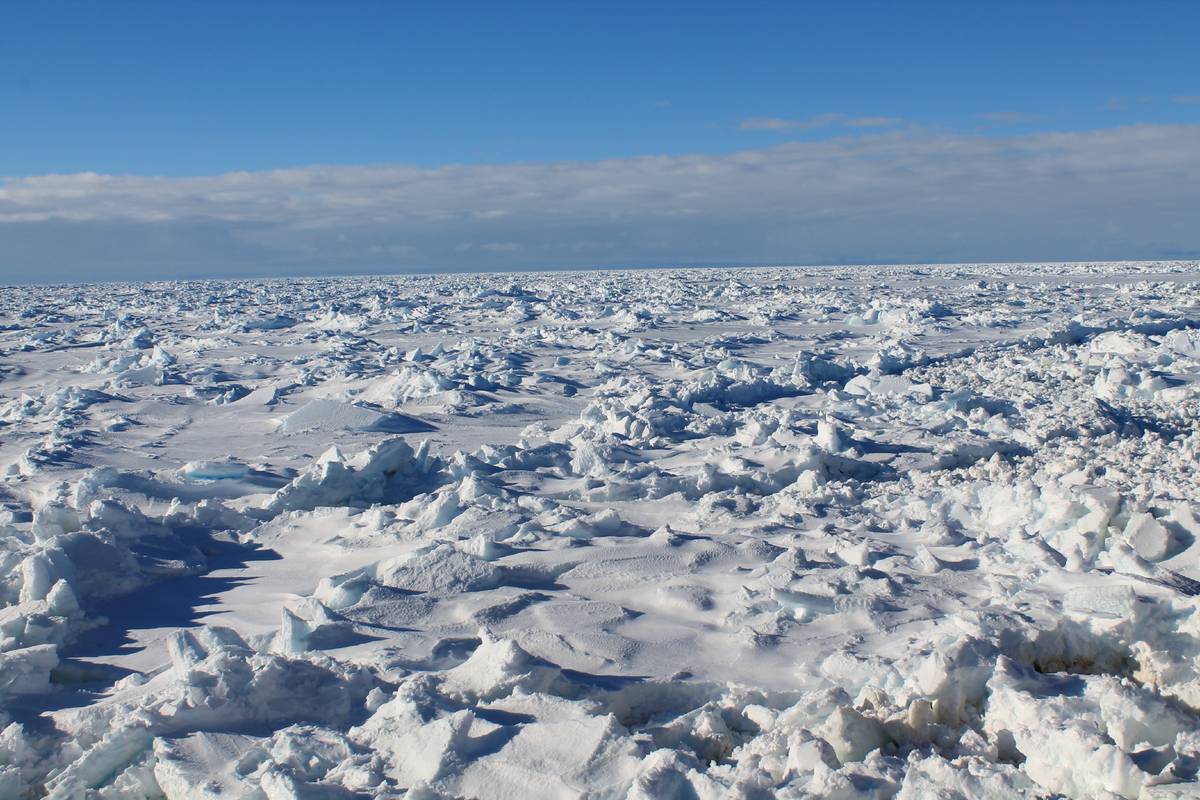
The $1 billion Great Barrier Reef funding is nonsensical. Australians, and their natural wonder, deserve so much better
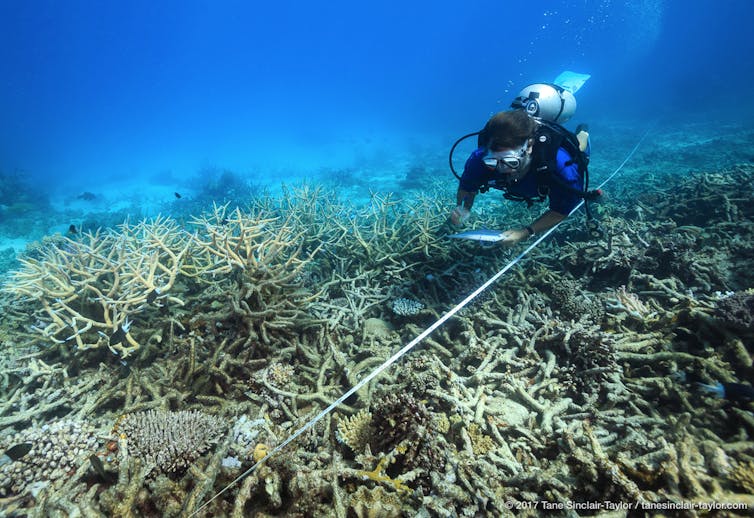
Today, the federal government is due to report back to UNESCO on its efforts to protect the Great Barrier Reef. The government’s announcement last week of A$1 billion of additional funding is welcome, but it will do little to allay UNESCO’s concerns.
Climate change is the number one threat to the Great Barrier Reef. While the new funding is meant to address other threats to the natural wonder and may improve its resilience, failing to address the climate threat is both disappointing and nonsensical.
As the below graph shows, ocean temperatures on the reef in December last year were the warmest on record. With this comes the risk of a fourth mass bleaching event this decade.
The Great Barrier Reef came close last year to being put on a list of World Heritage “in danger” sites. The funding announcement seems primarily about appeasing UNESCO, with one eye also on the upcoming federal election. But saving the Great Barrier Reef is not about throwing money at it – what matters is how the dollars are spent.

By The Numbers
The $1 billion package proposed by the government comprises:
58% to address the land-based causes of water quality issues impacting the World Heritage Area
26% to reduce crown-of-thorns starfish and prevent illegal fishing
9% for new scientific technologies
7% allocated to local communities – including Traditional Owners – for habitat restoration, citizen science and reducing marine debris.
The measures to be funded are all important. But they’re nowhere near as important as addressing the root cause of climate change: greenhouse gas emissions. Most of the $1 billion should have been used to help Australia phase out fossil fuels.
What’s more, the federal and Queensland governments continue to approve new coal and gas projects. Doing all this, while knowing the grave threat climate change poses to the Great Barrier Reef, demonstrates the incoherence of government policies.

Devil In The Detail
When we drill further into the detail, it becomes even more clear the funding package is not as impressive as it may first appear.
The $1 billion funding has been allocated over nine years. This is far beyond the time frame to which any government can sensibly commit, given four-year election cycles. A major funding increase is needed urgently, and certainly within a single term of government.
Also, federal Labor’s funding proposal for the Great Barrier Reef must be increased.
Another concern is the funding allocation for new scientific technologies such as coral seeding, developing heat-resistant corals and cloud brightening. Some of these technologies may have produced positive results at a small scale. But none has yet proved feasible at the wide scale necessary to make a real difference for the Great Barrier Reef.
Efforts to address water quality are important. After climate change, poor water quality is the most pressing problem facing the reef. It’s largely caused by nutrients, pesticides and sediment runoff from agriculture and coastal development.
But governments have already spent hundreds of millions trying to improve water quality, with only limited success. Reducing water pollution requires more effective spending, not just more funds.
This is just one example of how money alone cannot fix all the Great Barrier Reef’s problems. Improving water quality requires the right balance between voluntary industry-led approaches and enforcing the rules.
The Queensland government must greatly increase its compliance and enforcement on matters such as fertiliser runoff entering creeks that flow to the reef. While many farmers are doing the right thing, others clearly are not.
And to improve water quality, governments must be prepared to limit clearing and agriculture expansion in reef catchment areas.
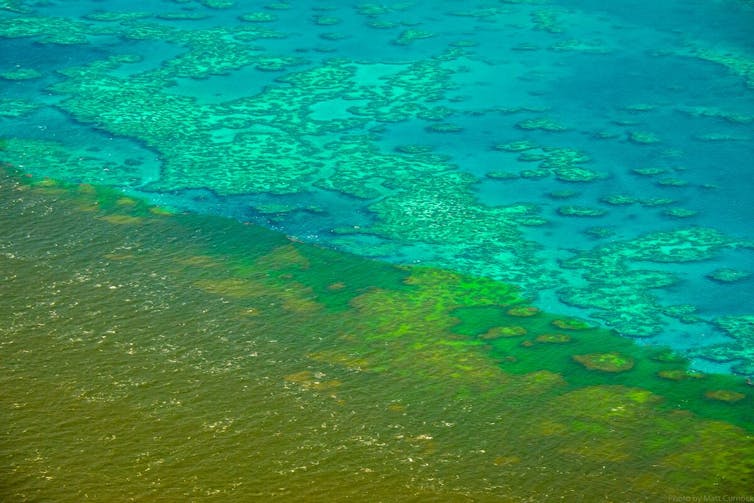
Learning From Our Mistakes
For years, the federal government has known the pressures facing the Great Barrier Reef. But it continues to maintain a “business as usual” attitude in the face of the worsening climate crisis. Governments worldwide must dramatically increase their climate ambitions – and for the Great Barrier Reef, this action should start at home.
As the Murray-Darling Basin experience shows, throwing funding at an environmental catastrophe does not fix the problem, especially if the core issue remains unaddressed.
The government must also better allocate funds to achieve effective and timely “adaptive management”. This involves decision-making that can be adjusted as outcomes become better understood.
Such management should include considering both the good and bad outcomes of reef interventions to date – both those controlled by government agencies and those managed by external groups such as the Great Barrier Reef Foundation.
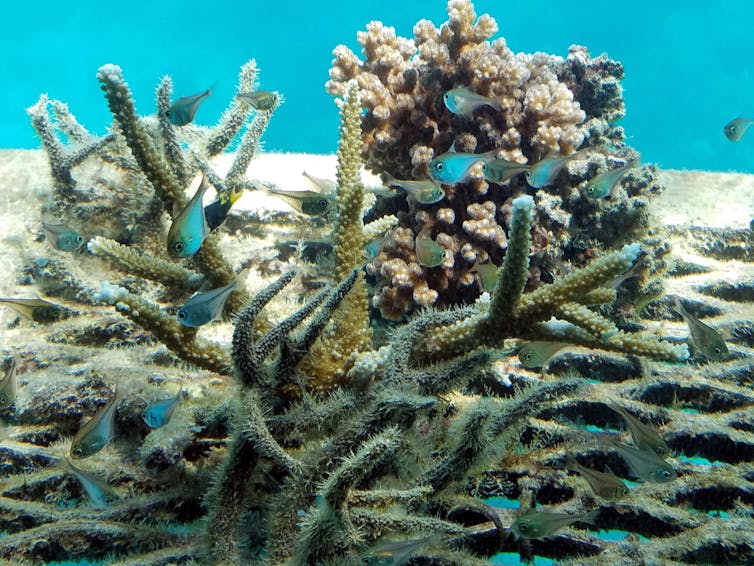
This latest government funding boost is welcome, but suspiciously timed. Environmental policy and budget allocations should not be about a government’s reputation and firming up its electoral prospects – especially when so much is at stake.
UNESCO is likely to welcome the additional efforts to address water quality. But it has specifically urged Australia to take “accelerated action at all possible levels” to address the climate threat. It remains to be seen whether UNESCO will continue to pressure the federal government on that front.
Amid all this, a key question remains. As the the Great Barrier Reef continues to decline, will Australians re-elect a federal government that supports industries harming the environment?
One thing is certain: Australians, and their Great Barrier Reef, deserve so much more.![]()
Jon C. Day, PSM, Adjunct Senior Research Fellow, ARC Centre of Excellence for Coral Reef Studies, James Cook University and Scott F. Heron, Associate Professor, James Cook University
This article is republished from The Conversation under a Creative Commons license. Read the original article.
Research Suggests Paris Agreement Limits Still Catastrophic For Coral Reefs
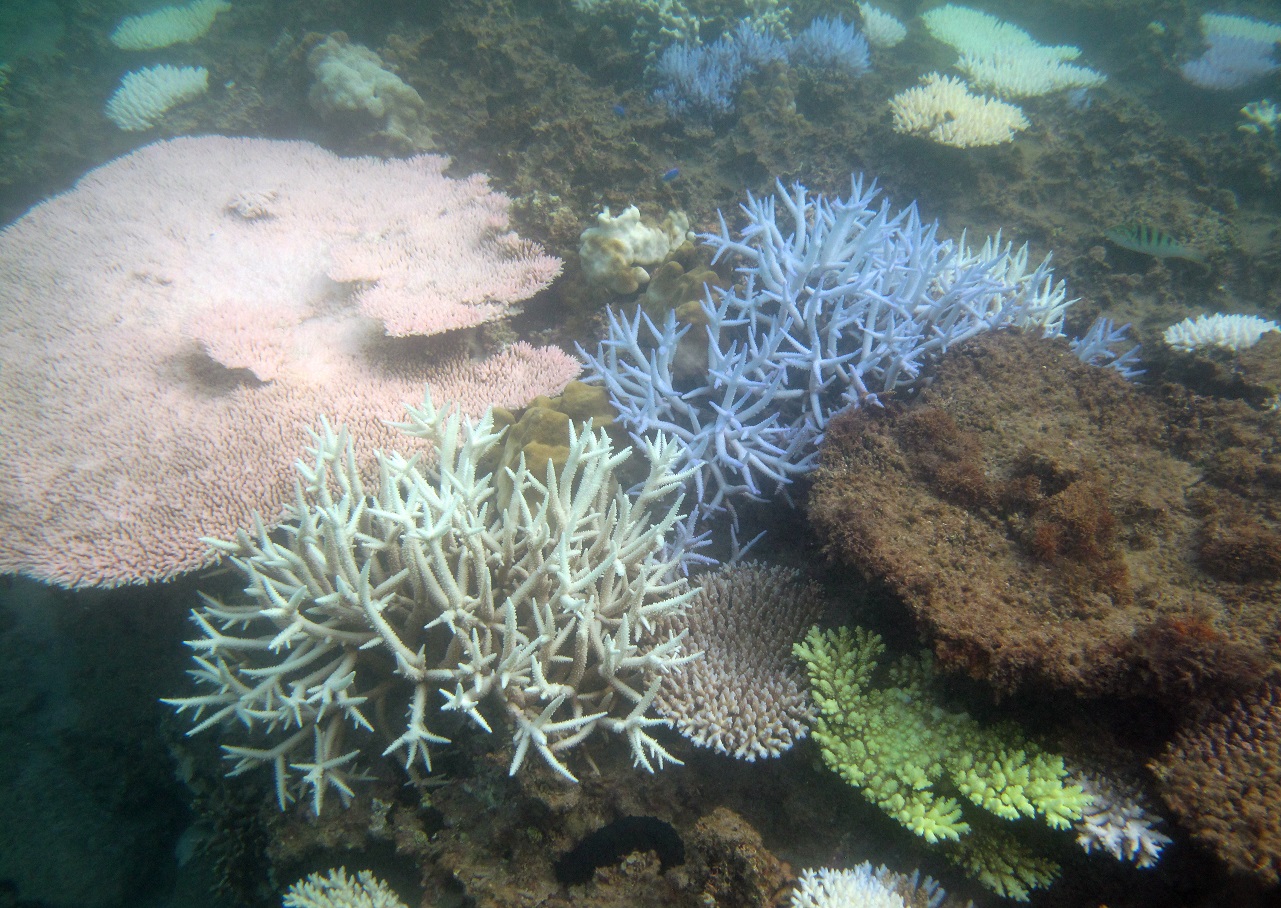
Extreme Heat Is The 'New Normal' For The Ocean
Climate Change Has Likely Begun To Suffocate The World’s Fisheries
Avalon Golf Course Bushcare Needs You
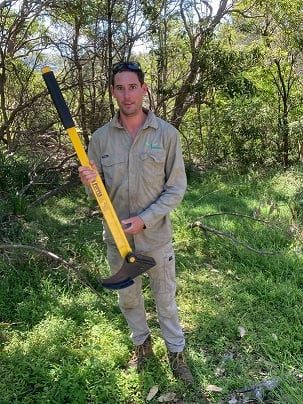
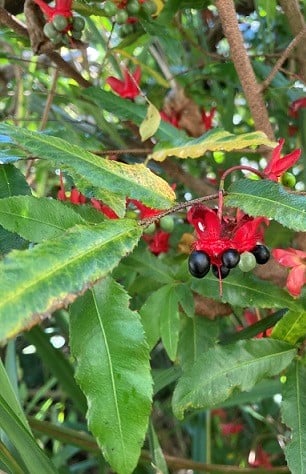
Pittwater Reserves + Others
A History Of The Campaign For Preservation Of The Warriewood Escarpment by David Palmer OAM and Angus Gordon OAM
Angophora Reserve - Angophora Reserve Flowers
Annie Wyatt Reserve - A Pictorial
Avalon's Village Green: Avalon Park Becomes Dunbar Park - Some History + Toongari Reserve and Catalpa Reserve
Bairne Walking Track Ku-Ring-Gai Chase NP by Kevin Murray
Bangalley Headland Bangalley Mid Winter
Banksias of Pittwater
Barrenjoey Headland: Spring flowers Barrenjoey Headland after fire
Bayview Baths
Bayview Wetlands
Beeby Park
Bilgola Beach
Botham's Beach
Bungan Beach Bush Care
Careel Bay Saltmarsh plants
Careel Bay Birds
Careel Bay Clean Up day
Careel Bay Playing Fields History and Current
Careel Creek
Careel Creek - If you rebuild it they will come
Centre trail in Ku-ring-gai Chase National Park
Chiltern Track- Ingleside by Marita Macrae
Clareville Beach
Clareville/Long Beach Reserve + some History
Coastal Stability Series: Cabbage Tree Bay To Barrenjoey To Observation Point by John Illingsworth, Pittwater Pathways, and Dr. Peter Mitchell OAM
Cowan Track by Kevin Murray
Curl Curl To Freshwater Walk: October 2021 by Kevin Murray and Joe Mills
Currawong and Palm Beach Views - Winter 2018
Currawong-Mackerel-The Basin A Stroll In Early November 2021 - photos by Selena Griffith
Currawong State Park Currawong Beach + Currawong Creek
Deep Creek To Warriewood Walk photos by Joe Mills
Drone Gives A New View On Coastal Stability; Bungan: Bungan Headland To Newport Beach + Bilgola: North Newport Beach To Avalon + Bangalley: Avalon Headland To Palm Beach
Dunbar Park - Some History + Toongari Reserve and Catalpa Reserve
Dundundra Falls Reserve: August 2020 photos by Selena Griffith - Listed in 1935
Elsie Track, Scotland Island
Elvina Track in Late Winter 2019 by Penny Gleen
Elvina Bay Walking Track: Spring 2020 photos by Joe Mills
Elvina Bay-Lovett Bay Loop Spring 2020 by Kevin Murray and Joe Mills
Fern Creek - Ingleside Escarpment To Warriewood Walk + Some History photos by Joe Mills
Ingleside
Ingleside Wildflowers August 2013
Irrawong - Ingleside Escarpment Trail Walk Spring 2020 photos by Joe Mills
Irrawong - Mullet Creek Restoration
Katandra Bushland Sanctuary - Ingleside
McCarrs Creek
McCarr's Creek to Church Point to Bayview Waterfront Path
McKay Reserve
Mona Vale Beach - A Stroll Along, Spring 2021 by Kevin Murray
Mona Vale Headland, Basin and Beach Restoration
Mount Murray Anderson Walking Track by Kevin Murray and Joe Mills
Mullet Creek
Narrabeen Creek
Narrabeen Lagoon Catchment: Past Notes Present Photos by Margaret Woods
Narrabeen Lagoon State Park
Narrabeen Lagoon State Park Expansion
Narrabeen Rockshelf Aquatic Reserve
Nerang Track, Terrey Hills by Bea Pierce
Newport Bushlink - the Crown of the Hill Linked Reserves
Newport Community Garden - Woolcott Reserve
Newport to Bilgola Bushlink 'From The Crown To The Sea' Paths: Founded In 1956 - A Tip and Quarry Becomes Green Space For People and Wildlife
Pittwater spring: waterbirds return to Wetlands
Pittwater's Lone Rangers - 120 Years of Ku-Ring-Gai Chase and the Men of Flowers Inspired by Eccleston Du Faur
Pittwater's Parallel Estuary - The Cowan 'Creek
Riddle Reserve, Bayview
Salvation Loop Trail, Ku-Ring-Gai Chase National Park- Spring 2020 - by Selena Griffith
Stapleton Reserve
Stapleton Park Reserve In Spring 2020: An Urban Ark Of Plants Found Nowhere Else
The Chiltern Track
The Resolute Beach Loop Track At West Head In Ku-Ring-Gai Chase National Park by Kevin Murray
Towlers Bay Walking Track by Joe Mills
Trafalgar Square, Newport: A 'Commons' Park Dedicated By Private Landholders - The Green Heart Of This Community
Turimetta Beach Reserve by Joe Mills, Bea Pierce and Lesley
Turimetta Beach Reserve: Old & New Images (by Kevin Murray) + Some History
Turimetta Headland
Warriewood Wetlands and Irrawong Reserve
Whale Beach Ocean Reserve: 'The Strand' - Some History On Another Great Protected Pittwater Reserve
Winji Jimmi - Water Maze

New Shorebirds WingThing For Youngsters Available To Download
A Shorebirds WingThing educational brochure for kids (A5) helps children learn about shorebirds, their life and journey. The 2021 revised brochure version was published in February 2021 and is available now. You can download a file copy here.
If you would like a free print copy of this brochure, please send a self-addressed envelope with A$1.10 postage (or larger if you would like it unfolded) affixed to: BirdLife Australia, Shorebird WingThing Request, 2-05Shorebird WingThing/60 Leicester St, Carlton VIC 3053.

 Shorebird Identification Booklet
Shorebird Identification Booklet
The Migratory Shorebird Program has just released the third edition of its hugely popular Shorebird Identification Booklet. The team has thoroughly revised and updated this pocket-sized companion for all shorebird counters and interested birders, with lots of useful information on our most common shorebirds, key identification features, sighting distribution maps and short articles on some of BirdLife’s shorebird activities.
The booklet can be downloaded here in PDF file format: http://www.birdlife.org.au/documents/Shorebird_ID_Booklet_V3.pdf
Paper copies can be ordered as well, see http://www.birdlife.org.au/projects/shorebirds-2020/counter-resources for details.
Download BirdLife Australia's children’s education kit to help them learn more about our wading birdlife
Shorebirds are a group of wading birds that can be found feeding on swamps, tidal mudflats, estuaries, beaches and open country. For many people, shorebirds are just those brown birds feeding a long way out on the mud but they are actually a remarkably diverse collection of birds including stilts, sandpipers, snipe, curlews, godwits, plovers and oystercatchers. Each species is superbly adapted to suit its preferred habitat. The Red-necked Stint is as small as a sparrow, with relatively short legs and bill that it pecks food from the surface of the mud with, whereas the Eastern Curlew is over two feet long with a exceptionally long legs and a massively curved beak that it thrusts deep down into the mud to pull out crabs, worms and other creatures hidden below the surface.
Some shorebirds are fairly drab in plumage, especially when they are visiting Australia in their non-breeding season, but when they migrate to their Arctic nesting grounds, they develop a vibrant flush of bright colours to attract a mate. We have 37 types of shorebirds that annually migrate to Australia on some of the most lengthy and arduous journeys in the animal kingdom, but there are also 18 shorebirds that call Australia home all year round.
What all our shorebirds have in common—be they large or small, seasoned traveller or homebody, brightly coloured or in muted tones—is that each species needs adequate safe areas where they can successfully feed and breed.
The National Shorebird Monitoring Program is managed and supported by BirdLife Australia.
This project is supported by Glenelg Hopkins Catchment Management Authority and Hunter Local Land Services through funding from the Australian Government’s National Landcare Program. Funding from Helen Macpherson Smith Trust and Port Phillip Bay Fund is acknowledged.
The National Shorebird Monitoring Program is made possible with the help of over 1,600 volunteers working in coastal and inland habitats all over Australia.
The National Shorebird Monitoring program (started as the Shorebirds 2020 project initiated to re-invigorate monitoring around Australia) is raising awareness of how incredible shorebirds are, and actively engaging the community to participate in gathering information needed to conserve shorebirds.
In the short term, the destruction of tidal ecosystems will need to be stopped, and our program is designed to strengthen the case for protecting these important habitats.
In the long term, there will be a need to mitigate against the likely effects of climate change on a species that travels across the entire range of latitudes where impacts are likely.
The identification and protection of critical areas for shorebirds will need to continue in order to guard against the potential threats associated with habitats in close proximity to nearly half the human population.
Here in Australia, the place where these birds grow up and spend most of their lives, continued monitoring is necessary to inform the best management practice to maintain shorebird populations.
BirdLife Australia believe that we can help secure a brighter future for these remarkable birds by educating stakeholders, gathering information on how and why shorebird populations are changing, and working to grow the community of people who care about shorebirds.
To find out more visit: http://www.birdlife.org.au/projects/shorebirds-2020/shorebirds-2020-program
Aussie Bread Tags Collection Points

Vale Glenn Wheatley
Morning Of The Earth: 50th Anniversary Screening At Cremorne
Morning of the Earth 50th Anniversary screening with director Q&A Wed March 9 at the Hayden Orpheum Picture Palace, Cremorne. Beautifully remastered in 4K. One show only! Tickets: http://ow.ly/Rkhc30s774W
AvPals: Suspension Of Activities Until March 2022
 AvPals regret to announce the suspension of all our activities until March 2022. This is of course due to the ongoing Covid issues. We can see no reason why we should not resume normal training in early March 2022 and we invite you to follow this webpage or read our newsletters. Subscribe HERE if you do not receive our newsletters.
AvPals regret to announce the suspension of all our activities until March 2022. This is of course due to the ongoing Covid issues. We can see no reason why we should not resume normal training in early March 2022 and we invite you to follow this webpage or read our newsletters. Subscribe HERE if you do not receive our newsletters.Brain Function Boosted By Daily Physical Activity In Middle-Aged And Older Adults
New Imaging Method Reveals Causes Of Cerebral Oedema
Parkinson’s disease: men who eat more berries and red wine may live longer – new research

Fruits and vegetables contain many nutrients and minerals that play an important role in helping us maintain good health. Take flavonoids, for example. These are a group of naturally occurring compounds that are found in many foods – including citrus fruits, berries, red wine and even dark chocolate.
Flavonoids act as antioxidants, which help to prevent or slow damage to cells which may lead to diseases – such as cancer. They also reduce inflammation in the body, which is common in many chronic diseases – including neurodegenerative ones, such as Alzheimer’s or Parkinson’s disease.
Research shows that flavonoids are good for our brain health, with studies showing diets high in fruits and veggies may slow cognitive decline and lower dementia risk. And now, a recent study has suggested that people with Parkinson’s disease who consume diets high in flavonoids may live longer than those who don’t.
To conduct their study, a team of researchers analysed data from 121,700 female registered nurses and 51,529 male health professionals. They chose to look at these two groups because many aspects of their lifestyles which might influence their disease risk would be similar – such as activity levels, education and years in work. Information on their diets has been gathered every two to four years, beginning in 1975 for the women and 1986 for the men. The data from these groups has been used in many other high quality nutrition studies.
At the time when this new study was conducted, 599 of the women and 652 of the men had been diagnosed with Parkinson’s disease. From the foods these women and men reported consuming, it was possible to calculate their intake of flavonoids.
It was found that the men with Parkinson’s disease who ate the most flavonoids as part of their diet had a 47% lower risk of dying from any cause compared to men who consumed the least flavonoids in their diet. But for women, the amount of flavonoids they consumed in their diet had no effect on their risk of death from all causes. So the tentative conclusion from this study is that flavonoids may reduce the risk of men with Parkinson’s disease from dying, although not in women. It’s not currently known why the men saw greater benefit.
Cherry Picking?
As with any observational nutrition study of this type – where researchers simply observe outcomes without trying to intervene in the group (such as intervening by having half of the group eat a specific diet) – it’s not possible to prove a causal link. In the case of the present study, a causal link would mean that eating more flavonoids directly reduces the risk of men with Parkinson’s disease from dying.

A main reason for not being able to prove causality is that other dietary and lifestyle factors may also have contributed to extending lifespan. The authors did compensate for this to some extent by making statistical adjustments for other potentially beneficial nutrients – such as beta-carotene and the antioxidant vitamins C and E – and for possibly damaging lifestyle factors such as smoking, being overweight and not exercising enough.
But this still doesn’t take into account many other dietary, lifestyle and genetic factors that could contribute to a person’s risk. One example is exposure to herbicides and pesticides.
One factor that did influence the study’s results was the type of flavonoids they looked at. There are many different types of flavonoids, and two groups – known as anthocyanins and flavan-3-ols – were found in this study to be most strongly linked to prolonging life. Anthocyanins give berries and red wine their red and purple colours, and flavan-3-ols are found at high levels in green tea.
But it’s not known how these flavonoids may benefit the brain. As with other degenerative brain disorders, the progression of Parkinson’s disease is likely to involve oxidative stress (when too many highly reactive molecules, called free radicals, are produced for antioxidant defences to handle) and brain inflammation. Many flavonoids, including anthocyanins and flavan-3-ols, have been shown in experimental studies to have antioxidant and anti-inflammatory properties.
Other mechanisms may also be involved. Flavonoids can have a positive effect on the gut microbiome, which may decrease the inflammation that contributes to Parkinson’s. Also, as Parkinson’s disease progresses, many neurological pathways such as the dopamine pathway are affected. Dopamine plays a vital role in regulating movement by the body. But the possible role of flavonoids in improving the functioning of these pathways is not known.
Though this study examined risk of death in people who already had Parkinson’s disease, other studies have also shown that diets high in flavonoids lower the risk of developing Parkinson’s disease. The benefit was also shown to be greater in men – although again it is not clear why.
While there are many factors that might have influenced the results of this latest study, there’s still a good body of evidence suggesting that diets rich in flavonoids can help protect against many degenerative brain disorders – including Parkinson’s disease. And fortunately for us, flavonoids are found in many fruits and vegetables that we can readily buy from our supermarket.![]()
Richard Hoffman, Associate lecturer, Nutritional Biochemistry, University of Hertfordshire
This article is republished from The Conversation under a Creative Commons license. Read the original article.
Would you pass this financial literacy quiz? Many won’t – and it’s affecting expensive aged care decisions

Paying for residential aged care accommodation in Australia is complex. Residents can pay a lump sum payment known as a refundable accommodation deposit (RAD), a rental style payment known as a daily combination payment (DAP), or a combination of both.
Deciding between the two is an important, complex financial decision and influenced by a host of factors unique to each person. And the stakes are high; it’s common to sell the family home to pay for aged care accommodation. Making the wrong accommodation payment decision could lead to reduced income and wealth, paying more for care, and having less to leave in bequests when you pass away.
Many residents get help from loved ones to navigate their way into residential aged care because they are experiencing age-related cognitive decline. So how do people make this decision and what role does financial literacy play?
To find out, colleagues and I measured financial literacy among 589 informal carers that substantially helped a resident decide.
Our study found less than half of all respondents were financially literate. Many were underconfident in their financial literacy. Others were overconfident, potentially leading to accommodation payment decision mistakes.

The Role Of Financial Literacy
Our study explored whether financial literacy influenced the decision to consult a financial adviser and whether financial literacy impacted decision confidence, stress, and perceived decision complexity.
We used a validated financial literacy measure known as the “Big Three” questions. You can do the quiz below; we defined someone as financially literate if they got three questions correct.
This measured literacy on inflation, interest rate, and risk diversification. We also asked respondents to rate their financial literacy.
We found:
nearly one third of respondents were not certain the accommodation payment decision was the best for the resident financially
around 60% of respondents found deciding on how to pay for accommodation complex, and over half found deciding how to pay for accommodation stressful
less than half of all respondents were financially literate. Many were overconfident in their financial literacy, which could lead to worse financial outcomes for the resident.
Many respondents may have ignored complex information or used a mental shortcut (what researchers call “simplifying heuristics”) when making an accommodation payment decision. For example, they might sell their home and choose a RAD without considering the capital gain they could have received if they had kept the home.
Getting Advice
Just over one third of respondents used a financial advisor. More financial literacy was unlikely to have increased the use of a financial adviser. Highly financially literate individuals were more likely to use a financial adviser if they perceived their financial literacy as low.
Residential aged care providers also played a role. A respondent was more likely to use a financial adviser if the aged care provider suggested using a financial adviser, or informed them the resident had 28 days to make a payment decision once they entered care. While this condition should be in the final accommodation agreement, it may not be explicitly stated by the provider when discussing accommodation payment options.
We found higher financial literacy may help respondents understand the difference between a RAD and DAP, but was unlikely to increase decision confidence or reduce decision stress.
High financial literacy was associated with greater confidence only if respondents thought they had been enough time to make the decision. This suggests some people could make better decisions if aged care providers gave people more time to make a decision.
Respondents with high financial literacy were also more likely to be confident in their decision if the aged care provider didn’t say whether it preferred the resident to pay a RAD or a DAP.

So What Would Help?
It’s not possible to say whether RAD, DAP, or some combination of both is better; the answer depends on your circumstances. Selling the home when entering care may not be the best option financially.
The Financial Information Service run by Services Australia can help people better understand their financial affairs and how to use financial planning advice, but does not advise on which accommodation payment type is best.
Financial literacy education may help some people, but our study suggests benefits will be limited.
Each resident has unique financial and personal circumstances. To make an informed accommodation payment decision, you need to factor in and predict the future value of financial assets.
The Australian government is still exploring whether it should remove RADs, as suggested by the Royal Commission on Aged Care Quality and Safety. This would simplify the accommodation payment choice but likely take years to implement.
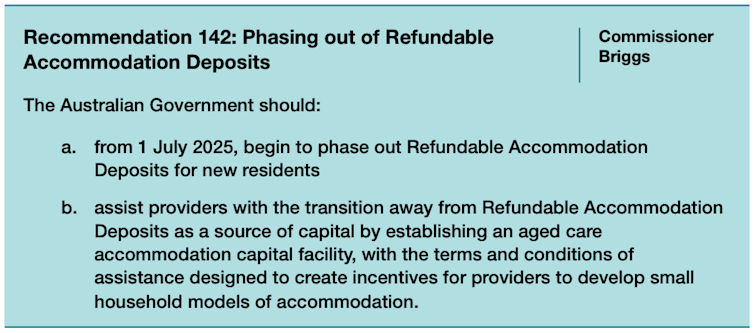
When discussing accommodation payment options, all residential aged care providers should ensure residents know they have 28 days to make a decision once they enter care.
That will help reduce decision complexity and stress and increase decision confidence.
Providers should also not express their preference for receiving a RAD or DAP, as our results show, this can make the decision more complex for people and give them less confidence in their decision.
The Australian government should also explore subsidising access to financial advice or establishing its own financial adviser service.
This would align with other Australian government programs to improve health and wealth outcomes for older Australians, such as prostate and breast cancer screening and Life Checks.
When moving into residential aged care, good financial outcomes are as important.![]()
Henry Cutler, Director, Centre for the Health Economy, Macquarie University
This article is republished from The Conversation under a Creative Commons license. Read the original article.
Property Industry Wipeout Dementia 2022
Reforming The Care System – Seniors Wanted
What we know now about COVID immunity after infection – including Omicron and Delta variants

COVID is rampant in Australia and many parts of the world right now. Some people battling or recovering from infection may wonder if catching COVID will give them longer term immunity for when the next wave comes.
Since the early days of the pandemic we’ve known COVID induces a wide range of immune responses and one infection provides partial protection from future infections.
Unfortunately, immunity wanes over time – people lose half their immunity every 3 months. Further, new variants continue to emerge that are partially resistant to key immune responses – antibodies that neutralise earlier strains – this is especially true of Omicron.
We’re starting to get a more detailed understanding of COVID immunity across variants. Here’s what we know so far …
Breakthrough Infection Happens But Vaccines Are Still A Must
Since around 95% of Australians over 16 have had at least two COVID vaccines, most people catching COVID now have previously been vaccinated – this is called “breakthrough infection”.
The vaccines are effective at substantially reducing severe COVID illness. They are less effective, particularly over time, at preventing infections, including with new variants. A third vaccine dose helps maintain immunity, and everyone eligible should get a booster as soon as possible.
Because the Astra-Zeneca vaccine is less effective than the Pfizer or Moderna vaccines, it’s critically important for vulnerable older Australians immunised with two Astra-Zeneca vaccinations to be boosted with a third vaccine dose as quickly as possible.
The good news is people first vaccinated with Astra-Zeneca and subsequently boosted with Pfizer or Moderna develop high levels of protective immune responses.
Recent work shows a nice boost in antibody immunity after breakthrough infection. This boost in antibody immunity may not be as fast or strong as getting a vaccine, but it has a big advantage in that the immunity is more specific to the infecting strain such as Delta.
The current vaccines are still based on the original strain isolated in Wuhan, China in early 2020. Several vaccine manufacturer’s are racing to update their vaccines for the Omicron variant (much as we do with the yearly flu vaccines), but these variant-specific vaccines are still some months away.
Infection Immunity Builds Where COVID Strikes First
Another potential advantage for immunity derived by infection (acquired in the respiratory tract) compared to vaccination (given into the muscle) is that immunity is better focused to the surfaces of the nose, throat and eyes. This is where COVID is first encountered.
Surface antibodies (termed immunoglobulin A) and specialised tissue “resident” immune cells (B and T-cells) are induced by infection but not intramuscular vaccination.
The level of protection offered by these “local” or “mucosal” responses is not yet clear in people, but some studies in animal models suggest they are helpful.

Delta Infection Offers A Little Protection Against Omicron
The Omicron variant is slowly replacing the Delta variant around the world. It is more transmissible and avoids antibodies more effectively.
Do people who have been infected with the Delta variant have an advantage in terms of protection from the Omicron variant? The two strains share some sequence changes, but Omicron has many more mutations than Delta.
Only a minority of neutralising antibodies that fight Delta can also neutralise the Omicron variant. That said, neutralising antibodies against Delta are better at fighting Omicron than previous strains. This is particularly true for people who have caught Delta and been previously vaccinated.
The reverse is also true – people who have caught Omicron have some improved antibody protection against Delta. This may not be much use as Delta is disappearing from prevalence, but the knowledge could be useful for future variants.
T-Cells Might Be Key To Cross-Variant Protection
There is considerable interest in a type of immunity called T-cells and their potential ability to fight COVID infection.
Theoretically, T-cells could assist in protecting against severe infection with new strains because T-cells usually cross react to all variants of SARS-CoV-2, the virus that causes COVID.
However, the evidence to date points to the central role of neutralising antibodies obtained from infection or vaccination in protection from both getting an infection and preventing severe disease. A recent unpublished study suggests neutralising antibodies are boosted by breakthrough infections but not T-cells. We know T-cells are very important in protecting from other infectious diseases and many cancers, but perhaps have a lesser role in COVID.
Gaining Immunity Isn’t The End Of The Story
Overall, infections with Delta and Omicron provide a boost in immunity against these strains. Infection will probably help protect individuals from reinfection with the same variant. Infection may offer a small amount of protection from different variants and potentially from future variants.
However, immunity will not be enduring and it is still possible to get severe infections and ongoing symptoms (termed “Long COVID”) from breakthrough infections. They are best avoided! Current booster vaccines along with social measures are our best way to stay healthy while we wait for Omicron-specific vaccines.![]()
Stephen Kent, Professor and Laboratory Head, The University of Melbourne
This article is republished from The Conversation under a Creative Commons license. Read the original article.
Safest Omicron Face Masks Revealed

Junior Irukandjis Team Presented By Woolworths Announced For 2022 ISA Juniors Campaign - Congratulations Gabi Spake - Kobi Clemments!
Tuesday 1st February, 2022: from Surfing Australia
The Junior Irukandjis Surfing Team presented by Woolworths has been announced ahead of the 2022 ISA World Junior Surfing Championship in El Salvador on May 27th – June 7th.
The number one ranked athletes from Under 16 and 18 Girls and Boys divisions automatically qualify for the team.
Surfing Australia Talent Pathway Coach and 2005 Women's World Champion Chelsea Hedges said: “ISA Junior event brings a high calibre of competition; it is a big achievement to be selected for this team and an amazing opportunity for Australia’s best junior athletes to get a taste of what their future could be at an Olympic Games.”
Woolworths comes on board as the presenting rights partner to the team which aligns perfectly with their focus on Grassroots junior surfing.
Woolworths Head of Community and Sponsorships, Sarah De La Mare said “Woolworths are committed to junior sport and we’re incredibly proud to be the foundation sponsor of the Junior Irukandji’s Surfing Team. We’re so excited to watch these young athletes represent our great surfing nation on the world stage and wear the junior Irukandji’s green and gold for the first time.”
2022 JUNIOR IRUKANDJIS SURFING TEAM PRESENTED BY WOOLWORTHS
U18 Girls
Keira Buckpitt
Ellie Harrison
Gabi Spake
U18 Boys
Kobi Clements
Lennix Smith
Jarvis Earle
U16 Girls
Willow Hardy
Isi Campbell
Sierra Kerr
U16 Boys
Eden Hasson
Willis Droomer
Hughie Vaughan
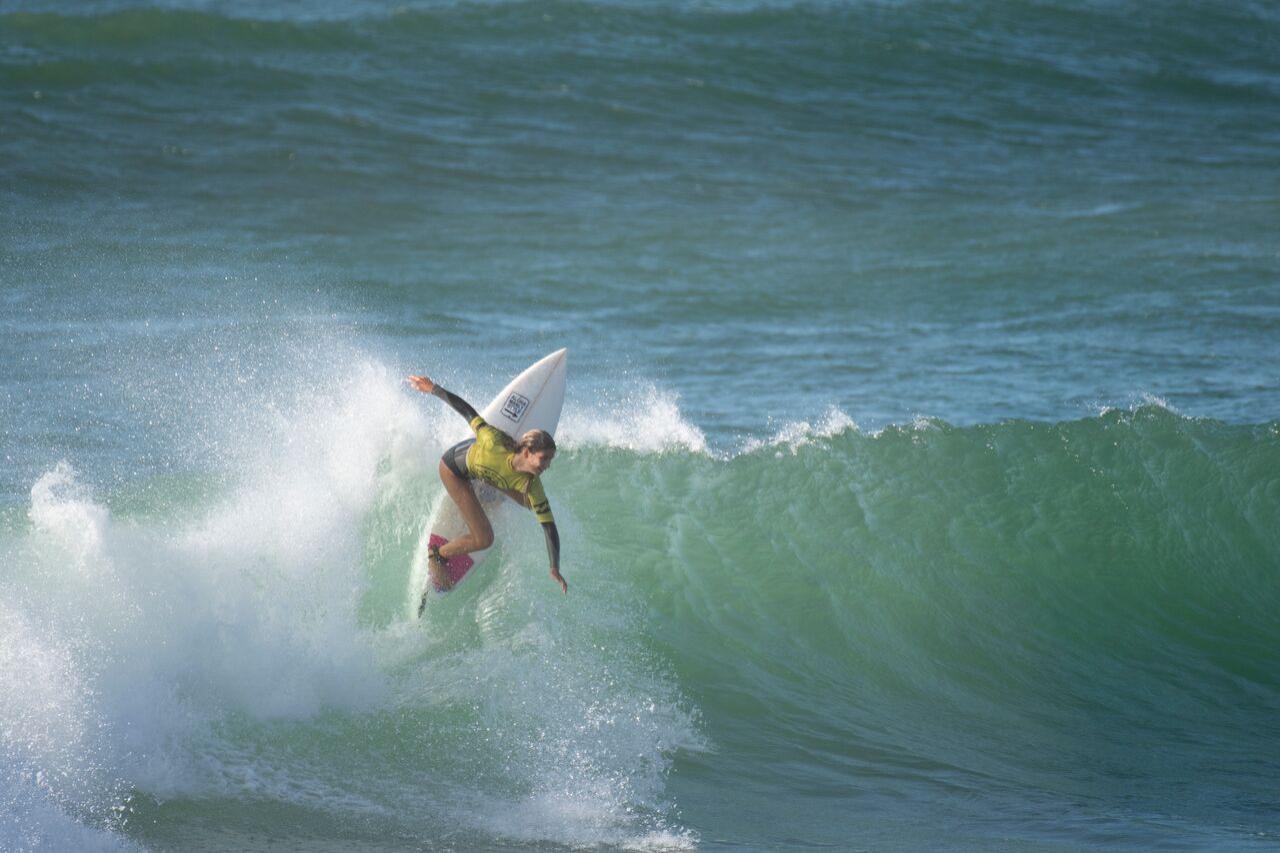
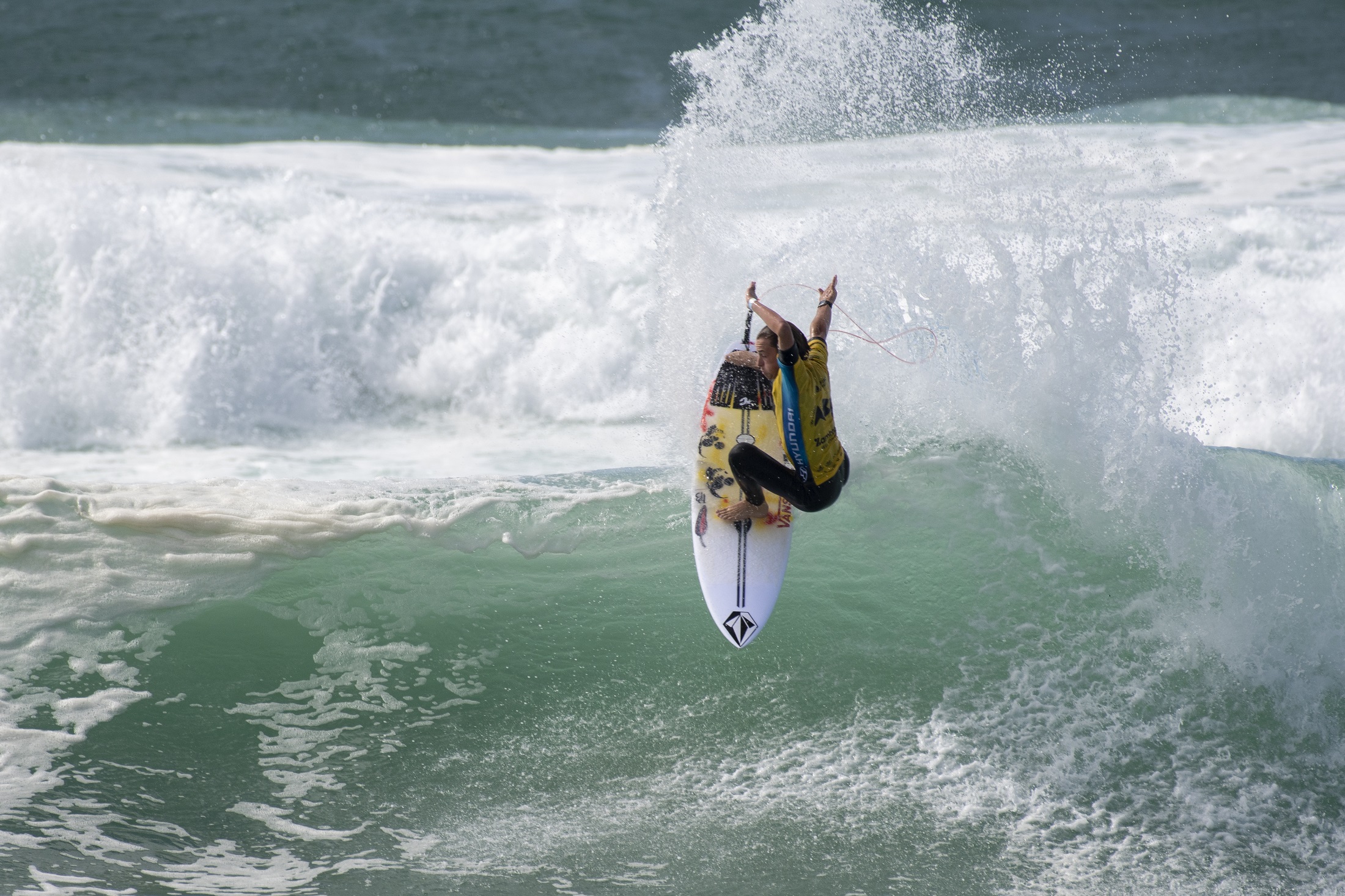 Kobi Clements - photo by Ethan Smith/Surfing NSW
Kobi Clements - photo by Ethan Smith/Surfing NSWIOC Session Approval Of Surfing For Inclusion In The Sports Programme Of The LA28 Olympic Games
Word Of The Week: Perfidious
Much Ado About Nothing On The Island This February


Applications Now Open For NSW Youth Advisory Council 2022
Morning Of The Earth: 50th Anniversary Screening At Cremorne
Morning of the Earth 50th Anniversary screening with director Q&A Wed March 9 at the Hayden Orpheum Picture Palace, Cremorne. Beautifully remastered in 4K. One show only! Tickets: http://ow.ly/Rkhc30s774W
At Seventeen
Janis Ian 1975

Spotify’s response to Rogan-gate falls short of its ethical and editorial obligations

Audio streaming giant Spotify is getting a crash course in the tension between free speech and the need to protect the public from harmful misinformation.
The Swedish-founded platform, which has 400 million active users, has faced a hail of criticism over misinformation broadcast on its most popular podcast, the Joe Rogan Experience.
Rogan, a former ultimate fighting commentator and television presenter, has argued healthy young people should not get a COVID vaccination. This is contrary to medical advice from governments all over the world, not to mention the World Health Organization.
A recent episode of his podcast, featuring virologist Robert Malone, drew criticism from public health experts over its various conspiracist claims about COVID vaccination programs.
There were widespread calls for Spotify to deplatform Rogan and his interviewees. Rock legend Neil Young issued an ultimatum that Spotify could broadcast Rogan or Young, but not both.
Spotify made its choice: the Joe Rogan Experience is still on the air, while Young’s music is gone, along with Joni Mitchell and Nils Lofgren, who removed their content in solidarity.
Spotify’s Response
Spotify co-founder Daniel Ek has since promised to tag controversial COVID-related content with links to a “hub” containing trustworthy information. But he stopped short of pledging to remove misinformation outright.
In a statement, Ek said:
We know we have a critical role to play in supporting creator expression while balancing it with the safety of our users. In that role, it is important to me that we don’t take on the position of being content censor while also making sure that there are rules in place and consequences for those who violate them.
Does It Go Far Enough?
Freedom of expression is important, but so is prevention of harm. When what is being advocated is likely to cause harm or loss of life, a line has been crossed. Spotify has a moral obligation to restrict speech that damages the public interest.
In response to the controversy, Spotify also publicly shared its rules of engagement. They are comprehensive and proactive in helping to make content creators aware of the lines that must not be crossed, while allowing for freedom of expression within these constraints.
Has Spotify fulfilled its duty of care to customers? If it applies the rules as stated, provides listeners with links to trustworthy information, and refuses to let controversial yet profitable content creators off the hook, this is certainly a move in the right direction.
Platform Or Publisher?
At the crux of the problem is the question of whether social media providers are platforms or publishers.
Spotify and other Big Tech players claim they are simply providing a platform for people’s opinions. But regulators are beginning to say no, they are in fact publishers of information, and like any publisher must be accountable for their content.

Facebook, YouTube, Twitter and other platforms have significant power to promote particular views and limit others, thereby influencing millions or even billions of users.
In the United States, these platforms have immunity from civil and criminal liability under a 1996 federal law that shields them from liability as sites that host user-generated content. Being US corporations, their actions are primarily based on US legislation.
It is an ingenious business model that allows Facebook, for example, to turn a steady stream of free user-posted content into US$28 billion in quarterly advertising revenue.
Established newspapers and magazines also sell advertising, but they pay journalists to write content and are legally liable for what they publish. It’s little wonder they are struggling to survive, and little wonder the tech platforms are keen to avoid similar responsibilities.
But the fact is that social media companies do make editorial decisions about what appears on their platforms. So it is not morally defensible to hide behind the legal protections afforded to them as platforms, when they operate as publishers and reap considerable profits by doing so.
How Best To Combat Misinformation?
Misinformation in the form of fake news, intentional disinformation and misinformed opinion has become a crucial issue for democratic systems around the world. How to combat this influence without compromising democratic values and free speech?
One way is to cultivate “news literacy” – an ability to discern misinformation. This can be done by making a practice of sampling news from across the political spectrum, then averaging out the message to the moderate middle. Most of us confine ourselves to the echo chamber of our preferred source, avoiding contrary opinions as we go.
If you are not sampling at least three reputable sources, you’re not getting the full picture. Here are the characteristics of a reputable news source.
Social media, meanwhile, should invest in artificial intelligence (AI) tools to sift the deluge of real-time content and flag potential fake news. Some progress in this area has been made, but there is room for improvement.
The tide is turning for the big social media companies. Governments around the world are formulating laws that will oblige them to be more responsible for the content they publish. They won’t have long to wait.![]()
David Tuffley, Senior Lecturer in Applied Ethics & CyberSecurity, Griffith University
This article is republished from The Conversation under a Creative Commons license. Read the original article.
How snowboarding became a marquee event at the Winter Olympics – but lost some of its cool factor in the process

The mass appeal of creative, youth-oriented events such as snowboarding and freestyle skiing at the Winter Olympics is a virtual case study of how the once radical can go mainstream.
And while audiences have come to love these relatively new sports, the story of snowboarding’s inclusion in the Olympics also reveals the unintended consequences of “success” for the image of the sport itself.
When snowboarding first emerged in the late 1960s and ’70s in North America, most of its early pioneers were young people who rejected competitive, organised sport. Inspired by surfing and skateboarding rather than skiing, they were seeking something that offered fun, self-expression and an alternative identity.
Despite some initial resistance from skiers and resorts, snowboarding’s popularity grew during the 1990s. Television and corporate sponsors identified its huge potential to attract the elusive young male market. Increasingly, transnational media corporations and events likes the X-Games and Gravity Games controlled and defined snowboarding.
While some snowboarders initially resisted “selling out”, many embraced the opportunities to develop the sport and carve out new careers for themselves as “extreme sport” athletes.
Early Resistance
Meanwhile, the Winter Olympics (always a more niche event compared with its summer counterpart) recognised snowboarding’s potential to attract younger viewers and international sponsors.
The International Olympic Committee (IOC) first included snowboarding in the 1998 Winter Olympics, but under the governance of the International Ski Federation (FIS) rather than the International Snowboard Federation. The loss of autonomy and control infuriated many snowboarders.
The world’s best halfpipe rider at the time, Norwegian Terje Haakonsen, was particularly vocal, refusing to be turned into a “uniform-wearing, flag-bearing, walking logo”. Many other snowboarders echoed his sentiments.
And while snowboarding’s assimilation continued, the four events that debuted in 1998 – men’s and women’s halfpipe and giant slalom – were largely treated as a sideshow. The athletes were perceived and portrayed as interlopers in the Olympic program. As The Washington Post put it:
Snowboarders are the official curiosity of the Nagano Winter Games. They’re totally new to the Olympics. They look different, they sound different, they are different.
When Canadian Ross Rebagliati tested positive for marijuana after winning the first snowboarding gold medal, the IOC revoked his medal, only to return it a few days later when Rebagliati’s lawyers found a loophole in the IOC/FIS drug policies. The scandal confirmed the view – of snowboarders as well as mainstream commentators – that snowboarding was not ready to become an Olympic sport.
Acceptance And Growth
By the 2002 Winter Olympics in Salt Lake City, however, the packaging of snowboarding had evolved and the sport’s second mainstream outing was deemed a resounding success. Nearly 32% of the US population (92 million people) watched the halfpipe competition in which Americans won gold, silver and bronze in the men’s event and gold in the women’s event.
Official broadcaster NBC reported a 23% ratings increase among 18-to-34-year-olds. For the IOC, the inclusion of snowboarding had become a game-changer, showcasing cool new sports celebrities for Olympic audiences, especially in the lucrative US market.
By the 2010 Winter Olympics in Vancouver, snowboarders were front and centre, with Shaun White from the US deemed the most “recognisable athlete”.
When White won his third gold in the halfpipe at the 2018 Olympics in Pyeongchang it attracted a record 22.6 million viewers in the US alone. Having qualified for his fifth Olympics, White will bring his star power to Beijing this year.
Women On Board
Women snowboarders have competed in all Olympic events since 1998, expanding opportunities for women in the sport and industry.
Olympic snowboarders such as Kelly Clark, Hannah Tetter, Torah Bright and Chloe Kim build on the efforts of previous generations of female snowboarders, carving out new space for girls and women in the sport.
In the process of wowing audiences, they’ve also inspired the next generation of stars like New Zealand’s Zoi Sadowski-Synnott and Japan’s Ono Mitsuki.
It’s estimated women will make up 45% of the athletes competing in Beijing this year, including in the new mixed team snowboard cross event, added as part of a broader IOC initiative to achieve gender parity.

Victim Of Its Own Success?
While the IOC held the line with certain rules and regulations (no stickers on snowboards, no large corporate logos on clothing or equipment), it has been increasingly willing to accommodate snowboarders’ individuality – allowing more clothing choices and athletes to select their own music for halfpipe runs.
Snowboarding’s success has also helped open up the Winter Olympics to other youth-focused sports, particularly free-skiing disciplines, as well as influencing the Summer Olympics’ embrace of BMX, surfing, skateboarding, sport climbing and breaking.
But there’s an irony to snowboarding’s mainstream success, too. While it has become popular with broader audiences, and companies and athletes have done very well from Olympic exposure, it appears to have lost its appeal among younger people.
Participation has been declining steadily in recent years – to the point where former pro snowboarder and action sports agent Circe Wallace has said the sport’s commodification and institutionalisation have been “the death knell of the unique culture and beauty of snowboarding”.
It’s a familiar story – youth-culture cool incorporated by mainstream businesses and organisations for profit. As the IOC continues to search out the latest youth-oriented sports to help it stay relevant, bring back younger viewers and attract corporate sponsors, we would do well to ask who, ultimately, are the real winners and the losers.![]()
Holly Thorpe, Professor in Sociology of Sport and Physical Culture, University of Waikato and Belinda Wheaton, Professor, Te Huataki Waiora School of Health, University of Waikato
This article is republished from The Conversation under a Creative Commons license. Read the original article.
Three tips to help you stay motivated to keep exercising all year long

February. The month of shattered dreams and ambitions. The trainers are gathering dust and chocolate bars have replaced protein bars. The gusto with which we attacked our new year resolutions is a vague memory.
If your motivation to stick to your resolution to exercise more this year is waning, you’re not alone. It’s suggested around 80% of people will have given up on their new year resolutions by February.
But the reason your motivation wanes might be because you chose the wrong motives and goals to begin with. And research shows us that choosing the right type of goal is the key to keeping us motivated over the long term.
Lower The Effort
Many of us believe that we need to grimace, contort, sweat and pant our way to a healthier life. So at the beginning of January, we put in a load of effort to help us reach our goals.
Unfortunately, our brain encourages us to avoid physical effort. This is why the excessive effort we use when exercising will work against us in the long run – leading us to feel less motivated to exercise by the end of January. Our brain is constantly monitoring our body for any changes from our resting state, which could mean danger to our health. The more physical effort we use, the more a signal is activated and our brain tells us that the activity just isn’t worth the effort and potential risk.
This is why minimising the effort we need to put into exercise may actually better help us stick to our resolutions in the long term. For example, if you’re dreading even a fifteen-minute jog, do five minutes instead. Or if you hate running but enjoy Zumba, do that instead. The golden rule is that the activity you’re trying to motivate yourself to do needs to be pleasurable. And research shows we’re much more likely to do something if it requires less effort – especially when we’re starting new exercise regimes.
The same principle applies to reducing the psychological effort required to exercise, as our brains also encourage us to avoid it – to such an extent that, when given the choice, we often prefer physical pain instead. It does this because it wants to save psychological effort for times of emergency.
When it comes to starting a new exercise regime in the new year, things like fitting workouts into our schedule or getting out of bed an hour earlier all require psychological effort. To reduce psychological effort, it may help to minimise needless decision-making. When it’s time to exercise, remove decisions like whether to walk or drive to exercise class, or put your trainers in the same place so you don’t have to look for them.

Although these sound like small decisions to make, they can all add up to us feeling less motivated to exercise when we’re required to make them. Research even shows that when we think our goals require little effort to achieve, we’re more likely to achieve them.
Choose Short-Term Goals
Another basic motivational mistake many of us made in January was to set our goals too far in the future. Many people start exercising to lose a few pounds – perhaps to fit into their favourite jeans again. But when the outcome is far in the future, our brains don’t associate the motivation (fitting into our jeans) with exercising – so we’re less inclined to exercise.
By choosing a goal that has a more immediate outcome, our brains will associate the outcome positively with exercise because they occur simultaneously. For example, the mood-boosting benefits of exercise occur more quickly than physical health changes so this may be a better motivator for you to keep exercising well past January. In short, make the reason for exercise an immediate one you can achieve – and the long-term benefits will follow.
Focus On ‘Being’ Instead Of ‘Having’
The final motivational fix is switching the type of goal you have. So-called “have” goals serve little purpose for our motivational brain, which focuses on more important things – such as being effective at what we do and making social bonds. An example of a “have” goal would be exercising so that you can have a better body. This type of goal is viewed as less important by our brain because it does not help us meet essential goals that help us thrive.
On the other hand, the types of goals that are more likely to keep us motivated are “be” goals. An example of a be goal would be exercising to be healthy or to be more athletic. Be goals are superior because humans tend to want to bond with other like-minded people based on our identities. This motivation is thought to have developed in our ancestral past, as forming bonds helped us to survive. So someone may find exercise easier to stick with if they’re doing it as a way to demonstrate their athleticism, for example. As a result, people do a better job of sticking to be goals, compared to other types of goals.
Even if you have fallen off the wagon slightly by the end of January, that doesn’t mean you have to give up on your goals entirely. But making some tweaks to them – and your approach to exercise – may help you better stick to your goals for the rest of the year.![]()
Ian Taylor, Senior Lecturer in Psychology, Loughborough University
This article is republished from The Conversation under a Creative Commons license. Read the original article.
‘Virtual influencers’ are here, but should Meta really be setting the ethical ground rules?

Earlier this month, Meta announced it is working on a set of ethical guidelines for “virtual influencers” – animated, typically computer-generated, characters designed to attract attention on social media.
When Facebook renamed itself Meta late last year, it heralded a pivot towards the “metaverse” – where virtual influencers will presumably one day roam in their thousands.
Even Meta admits the metaverse doesn’t really exist yet. The building blocks of a persistent, immersive virtual reality for everything from business to play are yet to be fully assembled. But virtual influencers are already online, and are surprisingly convincing.
But given its recent history, is Meta (née Facebook) really the right company to be setting the ethical standards for virtual influencers and the metaverse more broadly?
Who (Or What) Are Virtual Influencers?
Meta’s announcement notes the “rising phenomenon” of synthetic media – an umbrella term for images, video, voice or text generated by computerised technology, typically using artificial intelligence (AI) or automation.
Many virtual influencers incorporate elements of synthetic media in their design, ranging from completely digitally rendered bodies, to human models that are digitally masked with characters’ facial features.
At both ends of the scale, this process still relies heavily on human labour and input, from art direction for photo shoots to writing captions for social media. Like Meta’s vision of the metaverse, influencers that are entirely generated and powered by AI are a largely futuristic fantasy.
But even in their current form, virtual influencers are of serious value to Meta, both as attractions for their existing platforms and as avatars of the metaverse.
Interest in virtual influencers has rapidly expanded over the past five years, attracting huge audiences on social media and partnerships with major brands, including Audi, Bose, Calvin Klein, Samsung, and Chinese e-commerce platform TMall.
A competitive industry specialising in the production, management and promotion of virtual influencers has already sprung up, although it remains largely unregulated.
So far, India is the only country to address virtual influencers in national advertising standards, requiring brands “disclose to consumers that they are not interacting with a real human being” when posting sponsored content.
Ethical Guidelines
There is an urgent need for ethical guidelines, both to help producers and their brand partners navigate this new terrain, and more importantly to help users understand the content they’re engaging with.
Meta has warned that “synthetic media has the potential for both good and harm”, listing “representation and cultural appropriation” as specific issues of concern.
Indeed, despite their short lifespan, virtual influencers already have a history of overt racialisation and misrepresentation, raising ethical questions for producers who create digital characters with different demographic characteristics from their own.
But it’s far from clear whether Meta’s proposed guidelines will adequately address these questions.
Becky Owen, head of creator innovation and solutions at Meta Creative Shop, said the planned ethical framework “will help our brand partners and VI creators explore what’s possible, likely and desirable, and what’s not”.
This seeming emphasis on technological possibilities and brand partners’ desires leads to an inevitable impression that Meta is once again conflating commercial potential with ethical practice.
By its own count, Meta’s platforms already host more than 200 virtual influencers. But virtual influencers exist elsewhere too: they do viral dance challenges on TikTok, upload vlogs to YouTube, and post life updates on Sina Weibo. They appear “offline” at malls in Beijing and Singapore, on 3D billboards in Tokyo, and star in television commercials.
Gamekeeper, Or Poacher?
This brings us back to the question of whether Meta is the right company to set the ground rules for this emerging space.
The company’s history is tarred by unethical behaviour, from Facebook’s questionable beginnings in Mark Zuckerberg’s Harvard dorm room (as depicted in The Social Network) to large-scale privacy failings demonstrated in the Cambridge Analytica scandal.
In February 2021 Facebook showed how far it was willing to go to defend its interests, when it briefly banned all news content on Facebook in Australia to force the federal government to water down the Australian News Media Bargaining Code.
Last year also saw former Facebook executive Frances Haugen very publicly turn whistleblower, sharing a trove of internal documents with journalists and politicians.
These so-called “Facebook Papers” raised numerous concerns about the company’s conduct and ethics, including the revelation that Facebook’s own internal research showed Instagram can harm young people’s mental health, even leading to suicide.
Today, Meta is fighting US antitrust litigation that aims to restrain the company’s monopoly by potentially compelling it to sell key acquisitions including Instagram and WhatsApp.
Meanwhile, Meta is scrambling to integrate its messaging service across all three apps, effectively making them different interfaces for a shared back end that Meta will doubtless argue cannot feasibly be separated, no matter the outcomes of the current litigation.
Given this back story, Meta seems far from the ideal choice as ethical guardian of the metaverse.
The already extensive distribution of virtual influencers across platforms and markets highlights the need for ethical guidelines that go beyond the interests of one company – especially a company that stands to gain so much from the impending spectacle.![]()
Tama Leaver, Professor of Internet Studies, Curtin University and Rachel Berryman, PhD Candidate in Internet Studies, Curtin University
This article is republished from The Conversation under a Creative Commons license. Read the original article.
Ulysses at 100: why Joyce was so obsessed with the perfect blue cover

On February 2 2022, Ulysses turns 100, James Joyce would have turned 140, and I will turn 30-something.
To celebrate this tripartite birthday I am popping to the chemist to collect some eye drops. Then I’m heading to the Bodleian Library in Oxford to view one of the first editions of Ulysses. I won’t read it. I won’t even venture past its covers. I am interested in seeing the exact shade of blue that Joyce specified for the book’s wrappers. He was so particular about this aesthetic feature that he got his painter friend, Myron Nutting, to mix up the precise tint.
This is where the eye drops come in. I have a chronic condition that can make my eyes sore and my vision blurry. And I want to ensure that I can see Ulysses clearly, to properly assess the blueness of its cover. The irony is that Joyce’s eyesight was far worse than mine. He experienced severe eye pain, underwent multiple ocular surgeries and, at times, could barely see at all. Why, then, was he so obsessed with his book being such a specific hue of blue?
Ulysses Blue
Joyce’s biographer, Richard Ellmann, tells us that the cover of Ulysses was meant to match the blue of the Greek flag, to suggest the myth of ancient Greece and Homer. We know from his letters that Joyce sent a Greek flag to Nutting for him to colour-match. So, he was aiming for “Greek” blue.
We also know that Homer was a huge influence on Joyce. The structure of Ulysses parallels the structure of Homer’s Odyssey. So, it makes sense for Joyce to honour his literary hero through a subtle, yet exceedingly specific, decorative detail. But I think there’s more to it.

I am on a research odyssey to discover the impetus and symbolism behind “Ulysses blue”. I will go to the Bodleian with my eyes wide open, ready to let my visual experience of the famous blue book dictate my avenue of research.
But, given Joyce’s impaired vision, perhaps this isn’t the best approach. To understand Joyce’s perspective, I must shrug off my “ocularcentrism”.
Blindness In Joyce’s Texts
In her thoughtful new book, There Plant Eyes: A Personal and Cultural History of Blindness, writer and educator M. Leona Godin devotes several pages to her interactions with Ulysses. She discusses the “blind stripling” character who taps his way through Dublin, and through Ulysses, using his “slender cane”.
Godin praises Joyce’s ability to capture the musicality of the tapping cane and articulates the complexity of Joyce’s relationship with blindness: “Even if Joyce felt some kinship with the blind stripling, he was still a sight-oriented person who might think […] of the blind as ‘they’.”
Joyce would have loved Godin’s book, as he appears to have had a keen interest in blindness memoirs and advice guides written by blind people, for blind people (and their supporters). Scholars have largely glossed over Joyce’s references to blindness in his composition notebook. But I’m delving deeper to get to grips with Joyce’s thoughts on visual impairment.
It is fascinating to read Joyce’s depiction of the blind stripling in Ulysses, alongside one of the blindness books mentioned in his notes: Les Aveugles par un Aveugle (The Blind as Seen through Blind Eyes) (1899), by Maurice de la Sizeranne.
As I outlined in a public lecture last Bloomsday, there are several similarities, in terms of content and focus, between the two books.
The observations de la Sizeranne makes about his fellow blind man parallel those made by Ulysses’ protagonist Bloom about the blind stripling. Both Bloom and de la Sizeranne discuss the intriguing relationship between colour perception and touch, in blind experience, and suggest an additional blind sense: a “kind of sense of volume” involving the “nerves of the face” or the “forehead”. In reflecting blind experience onto his blind readers, de la Sizeranne - to borrow a phrase used in Ulysses - urges us to “see ourselves as others see us”.
In Joyce’s notes, the name of a hitherto unidentified “Dr Staub” is scrawled next to the title of de la Sizeranne’s book. Staub was believed to be one of Joyce’s eye doctors. However, I have discovered that he is, in fact, Dr Theodor Staub, the blind founder of the Swiss Library for the Blind.
It is unclear why Staub’s name appears next to Les Aveugles par un Aveugle. Whatever the precise connection, in jotting down Staub’s name Joyce, at the very least, demonstrated a desire to engage with the blind community and with books for the blind.
Blind, Blue Bards
In his final book, Finnegans Wake (1939), Joyce alludes to Ulysses. He depicts Shem, a partially sighted writer, reading a “usylessly unreadable Blue Book” in a “glaucous den”.
In ancient Greek, the word “glaucous” refers to blueish-green or blueish-grey. It’s also the root word of “glaucoma”. Joyce suffered from glaucoma, and, in one of his letters, he writes that Homer “went blind from glaucoma according to one of my doctors”.

So, perhaps “Ulysses blue” is a homage to glaucoma (via ancient Greece and Homer). By insisting on Greek-flag blue, was Joyce seeking, through rather associative means, to insert himself into a canon of blind writers?
There is no definite answer to this question. But, by recognising Joyce as a disabled writer with a genuine interest in articulating a wide range of bodily and sensory experiences, we open up new possibilities for accessing Ulysses in its centenary year. We should feel empowered to read Joyce’s blue book through our eyes, ears, and fingers.![]()
Cleo Hanaway-Oakley, Lecturer in Liberal Arts and English, University of Bristol
This article is republished from The Conversation under a Creative Commons license. Read the original article.
Killer whales taking food from fishing lines reveal something intriguing about human evolution
Luke Rendell, University of St AndrewsWho would go off to try and catch a fish if a sushi buffet had been laid on? Not me. Nor killer whales, according to new research that vividly illustrates the allure for these animals of the easy pickings provided by longline fisheries for Patagonian toothfish in the Indian Ocean.
In their study, French fisheries researcher Morgane Amelot and her colleagues examined over 119,000 photographs of individual killer whales taken between 2003 and 2018 around the Crozet Islands in the southern Indian Ocean. They produced an identity parade of whales caught red-handed (or finned) taking fish from baited hooks attached to a long main line.
Killer whales have been known to do this since the mid-1990s, but this analysis showed how the behaviour has spread through the population. The number of whales spotted around the fishing vessels suggest that by the end of the study period, the entire population was taking advantage of the buffet.
Humans, with the inexorable expansion of our fishing fleets, have inadvertently provided the whales with a new source of food, allowing them to expand their niche (the term ecologists use to described a species’ role in an ecosystem). This creates problems for both killer whales and toothfish that require more research to solve, but understanding how this behaviour spreads through populations also leads us into deeper intellectual waters. Might the way killer whales open up new niches mirror early human evolution?
Toothfish To Go
It is estimated that the whales now take around 163 tonnes of toothfish every year. We don’t know if the toothfish were part of the whales’ diet before they discovered the longlines, but the foraging method is undoubtedly new.
It’s not hard to see the attraction. Instead of all that tiresome swimming around, finding and then chasing the fish, the longliners are kind enough to gather and slowly wind them up from the depths and present them one by one for consumption – the open ocean equivalent of the conveyor belt in a sushi bar.

This isn’t confined to the Indian Ocean. In the northern Pacific, both killer and sperm whales have been exploiting longline fisheries for decades. In all these cases there is evidence that cultural transmission is behind the spread. In other words, the whales were learning about the new opportunity from seeing others taking advantage of it. Given that we know killer whales are capable of highly precise imitation of each other’s behaviour, it seems likely that cultural transmission, the foundation of killer-whale culture, underlies the spread of this behaviour in the Indian Ocean too.
What this research shows is an accelerated version of a process that has played out throughout the evolutionary history of the killer whale. In recent decades, we’ve learned more about how wild populations are divided into what are called ecotypes – different forms of killer whale, with distinct appearances, vocal behaviour, and often (but not always) highly specialised prey preferences.
Most famous are the fish-eating killer whales of the north-east Pacific, where for some populations, fully 80% of their diet can be comprised of a single salmon species. New specialisations are still being described – for example, another study published recently documented the cooperative tactics some groups use to take down blue whales.
The Whale Within
The origins of these ecotypes lie in the discovery of new ecological opportunities and the subsequent spread of new hunting tactics through cultural transmission – just like the spread of longline foraging. Sometimes the passing of these specialisations down generations has given rise to lineages of tradition so stable and separate that the distinctive diets have started affecting natural selection – the genomes of whales in separate lineages are diverging.
As a result, killer whales pose a conundrum for biologists, challenging the species concept itself. Are they one species, with sub-types, or should they be considered separate species? The debate rages on unresolved. The interaction between cultural traditions and genetic evolution that has produced this conundrum is called gene-culture co-evolution.
We know this process from our own societies. If you are an adult who is lactose tolerant, your genetic ancestry is intertwined at some point with a dairy farming culture.
The parallels to our own history go deeper, however. The story of human evolution has been a moving target in recent years. In contrast to the standard single-African-population origin story, we now know that what have been classified as multiple Homo species co-existed with modern humans. But were they separate species? Or could they better be described as ecotypes, specialised on diverse niches?
This relates to a provocative new view of human evolution, termed African multi-regionalism. It suggests that modern humans evolved as sets of interlinked groups throughout Africa, with divisions between groups being primarily related to ecology – different niches for different groups.
My colleagues and I have argued that culturally transmitted ecological specialisations may have led to diversification in humans in the same way as in killer whales. So perhaps the spread of killer whales taking fish from longlines can indeed help us understand how we ourselves came to be.![]()
Luke Rendell, MASTS Lecturer in Biology, University of St Andrews
This article is republished from The Conversation under a Creative Commons license. Read the original article.
Researchers Study Impact Of Waves Created By Recreational Boats On Shorelines - Vegetation
- When researchers compared the wake waves of the four boats during their most typical mode of operations, the data indicated that wakesurf boats require distances greater than 500 feet from the shoreline/docks and other boats (or the distance of a little less than 1.5 football fields) to decrease their wake wave characteristics to levels similar to the non-wakesurf boats.
- When researchers compared the wake waves of the four boats under conditions that generated the largest wake wave, the data indicated that wakesurf boats require distances greater than 425 feet from the shoreline/docks and other boats to decrease their wake wave characteristics to levels similar to the non-wakesurf boats.
- In both modes of operation, the suggested distance from shoreline/docks for wakesurf boats is more than twice the distance of the 200 feet currently recommended by Minnesota guidelines for common recreational boats.
- Under both slow and fast speed conditions, the wakesurf boats produced the largest waves in terms of height, energy, and power when compared to the non-wakesurf boats.
- Larger, more energetic waves need to travel a greater distance to decrease in wave height, energy, and power.
How The Connections Inside Bird Brains Work Together
What Is Your Dog’s Lifespan?: You Might Be Surprised
Novel Nanoparticle SARS-CoV-2 Vaccine Combines Immune Focusing And Self-Assembling Nanoparticles To Elicit More Potent Protection
Mechanism Revealed Behind Loss Of Smell With COVID-19
What we know now about COVID immunity after infection – including Omicron and Delta variants

COVID is rampant in Australia and many parts of the world right now. Some people battling or recovering from infection may wonder if catching COVID will give them longer term immunity for when the next wave comes.
Since the early days of the pandemic we’ve known COVID induces a wide range of immune responses and one infection provides partial protection from future infections.
Unfortunately, immunity wanes over time – people lose half their immunity every 3 months. Further, new variants continue to emerge that are partially resistant to key immune responses – antibodies that neutralise earlier strains – this is especially true of Omicron.
We’re starting to get a more detailed understanding of COVID immunity across variants. Here’s what we know so far …
Breakthrough Infection Happens But Vaccines Are Still A Must
Since around 95% of Australians over 16 have had at least two COVID vaccines, most people catching COVID now have previously been vaccinated – this is called “breakthrough infection”.
The vaccines are effective at substantially reducing severe COVID illness. They are less effective, particularly over time, at preventing infections, including with new variants. A third vaccine dose helps maintain immunity, and everyone eligible should get a booster as soon as possible.
Because the Astra-Zeneca vaccine is less effective than the Pfizer or Moderna vaccines, it’s critically important for vulnerable older Australians immunised with two Astra-Zeneca vaccinations to be boosted with a third vaccine dose as quickly as possible.
The good news is people first vaccinated with Astra-Zeneca and subsequently boosted with Pfizer or Moderna develop high levels of protective immune responses.
Recent work shows a nice boost in antibody immunity after breakthrough infection. This boost in antibody immunity may not be as fast or strong as getting a vaccine, but it has a big advantage in that the immunity is more specific to the infecting strain such as Delta.
The current vaccines are still based on the original strain isolated in Wuhan, China in early 2020. Several vaccine manufacturer’s are racing to update their vaccines for the Omicron variant (much as we do with the yearly flu vaccines), but these variant-specific vaccines are still some months away.
Infection Immunity Builds Where COVID Strikes First
Another potential advantage for immunity derived by infection (acquired in the respiratory tract) compared to vaccination (given into the muscle) is that immunity is better focused to the surfaces of the nose, throat and eyes. This is where COVID is first encountered.
Surface antibodies (termed immunoglobulin A) and specialised tissue “resident” immune cells (B and T-cells) are induced by infection but not intramuscular vaccination.
The level of protection offered by these “local” or “mucosal” responses is not yet clear in people, but some studies in animal models suggest they are helpful.

Delta Infection Offers A Little Protection Against Omicron
The Omicron variant is slowly replacing the Delta variant around the world. It is more transmissible and avoids antibodies more effectively.
Do people who have been infected with the Delta variant have an advantage in terms of protection from the Omicron variant? The two strains share some sequence changes, but Omicron has many more mutations than Delta.
Only a minority of neutralising antibodies that fight Delta can also neutralise the Omicron variant. That said, neutralising antibodies against Delta are better at fighting Omicron than previous strains. This is particularly true for people who have caught Delta and been previously vaccinated.
The reverse is also true – people who have caught Omicron have some improved antibody protection against Delta. This may not be much use as Delta is disappearing from prevalence, but the knowledge could be useful for future variants.
T-Cells Might Be Key To Cross-Variant Protection
There is considerable interest in a type of immunity called T-cells and their potential ability to fight COVID infection.
Theoretically, T-cells could assist in protecting against severe infection with new strains because T-cells usually cross react to all variants of SARS-CoV-2, the virus that causes COVID.
However, the evidence to date points to the central role of neutralising antibodies obtained from infection or vaccination in protection from both getting an infection and preventing severe disease. A recent unpublished study suggests neutralising antibodies are boosted by breakthrough infections but not T-cells. We know T-cells are very important in protecting from other infectious diseases and many cancers, but perhaps have a lesser role in COVID.
Gaining Immunity Isn’t The End Of The Story
Overall, infections with Delta and Omicron provide a boost in immunity against these strains. Infection will probably help protect individuals from reinfection with the same variant. Infection may offer a small amount of protection from different variants and potentially from future variants.
However, immunity will not be enduring and it is still possible to get severe infections and ongoing symptoms (termed “Long COVID”) from breakthrough infections. They are best avoided! Current booster vaccines along with social measures are our best way to stay healthy while we wait for Omicron-specific vaccines.![]()
Stephen Kent, Professor and Laboratory Head, The University of Melbourne
This article is republished from The Conversation under a Creative Commons license. Read the original article.
Our hospitals are at greater risk of flooding as the climate changes. We need better evacuation plans.
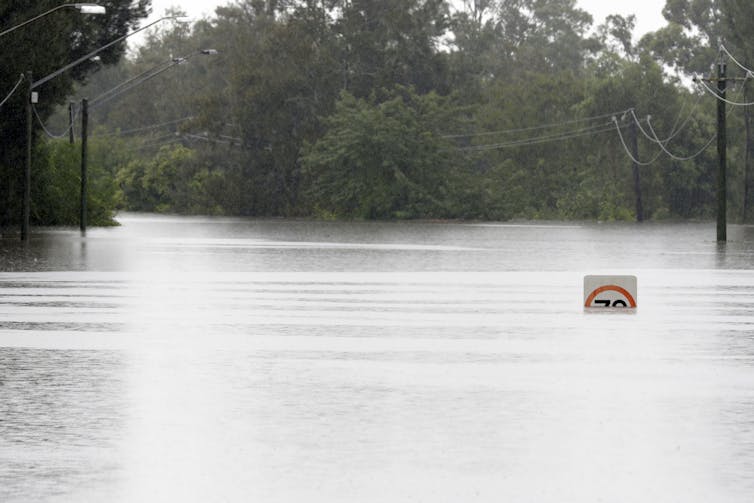
With hospitals under strain from COVID-19, we need to safeguard them against another threat set to increase as the world warms.
That threat? Flooding. Many Australian hospitals were built on cheap land near rivers. But as climate change loads the dice in favour of larger floods, areas previously safe may no longer be so. We must plan ahead to ensure patients and healthcare workers are not trapped by floodwaters.
Our new research shows future floods in low-lying areas of Western Sydney are likely to disrupt road networks, preventing safe evacuation of patients. Only last year, this region suffered its worst floods in decades, and more are expected as we enter a flooding cycle. This fast-growing region is rated one of Australia’s highest flooding risks, and hosts a number of healthcare facilities built in flood-prone areas.
The solution? We believe new approaches to mathematical modelling can help decision makers optimise plans for safe evacuation in different flooding scenarios. By cutting evacuation time, we hope these approaches can save lives.
Hospitals Were Not Built To Cope With Larger Floods
Around 80% of Australians live within 50 kilometres of the coast. As a result, many hospitals were built on low-lying land adjacent to seas or rivers. Most were designed without climate change risks in mind.
The major floods brought by La Nina last year, and the catastrophic 2010-2011 Queensland floods, have shown us how exposed many of our cities are to floods. Already in 2022, we have seen large floods up and down the east coast.
Climate change is predicted to bring Australia less rain overall, except for the tropical north. The rain that does fall will be more likely to fall in intense bursts. River flash floods from intense rain events or cyclones will pose an increasing threat to health facilities.
Some urban areas are on highly flood-prone areas. For example, the NSW Hawkesbury Nepean flood plan anticipates a flood similar to the infamous 1867 flood would result in around 90,000 people being evacuated.
That’s to say nothing of flooding from the sea. Around Australia, 75 hospitals and health service facilities are within 200 metres of the sea. That puts them at real risk from coastal inundation and erosion by the end of the century, if the seas rise by one metre as the Intergovernmental Panel on Climate Change predicts.
This is not a hypothetical scenario. Hospitals have already been left without power for days due to flooding, while others have been forced to evacuate patients. Only last year, floods up and down the east coast cut roads and forced authorities to find alternatives to hospitals for people unable to get through.
Clearly, this matters. Hospitals play a vital role in creating a disaster-resilient society, and it is critical they can keep operating in disaster situations.
The World Health Organization (WHO) has called for a better understanding of the threat posed by flooding.
What Can We Do To Prepare?
In our region, very little is known about how we might best evacuate hospitals in the event of a major flood. We simply haven’t done enough research.
What we found in our work is that the issue is extremely complex. Where would patients be evacuated to, for instance? How do you do it safely? Which routes would be safe in a major flood? How would medical staff get to other hospitals?
Evidence from recent floods suggests many hospitals in flooded areas will face major challenges transferring patients and resources to other healthcare facilities.
So what can hospitals do better?
At present, hospital administrators rely heavily on evacuation drills to test and improve emergency evacuation planning. These drills are expensive and disruptive and their effectiveness is difficult to assess.
We have found new approaches to mathematical modelling could greatly assist hospital managers plan for a flood to prevent them becoming disasters.
For example, analysis of Western Sydney’s Hawkesbury-Nepean Valley can visually show how different size flood events would impact on hospitals, healthcare and aged care facilities, as well as roads, bridges and electricity lines.

Imagine the Hawksbury-Nepean Valley area floods again like last year. In a scenario where a hospital floods and patients need evacuation, hospital administrators will face a conundrum. Which roads do they send the patients down?
Sophisticated modelling our team is undertaking will let us predict which routes are best, based on the roads most likely to flood, ambulance and staff availability, health needs of patients and the availability of suitable beds and staff in other hospitals. The models allow us to optimise routes for the most urgent patients.
For hospital administrators, the benefit of these models is the ability to glimpse the likeliest scenarios and plan ahead, before the floods happen.
Climate change can supercharge floods, as we are seeing more and more. Decision makers must plan ahead accordingly. Running flood and evacuation simulations now could help save lives in the future.![]()
Martin Loosemore, Professor of Construction Management, University of Technology Sydney; Maziar Yazdani, Doctoral candidate, UNSW, and Mohammad Mojtahedi, Senior lecturer, School of Built Environment, UNSW
This article is republished from The Conversation under a Creative Commons license. Read the original article.
Research Shows Depression And Anxiety Spiked In Pregnant Women During COVID-19 Pandemic
Towards Greener Smart Cities With Machine Learning-Based 'Sleep Schedules'

Power At Sea: Towards High-Performance Seawater Batteries
Disclaimer: These articles are not intended to provide medical advice, diagnosis or treatment. Views expressed here do not necessarily reflect those of Pittwater Online News or its staff.